1970s Men’s Fashion Trends: A Decade of Style and Innovation

The 1970s were a transformative decade for men’s fashion, marked by bold experimentation, self-expression, and the breaking of traditional style norms. As a period of significant cultural and social change, fashion reflected broader movements such as the rise of disco, the influence of rock music, and the lasting impact of the hippie movement from the 1960s. Men’s fashion in the 1970s embraced both vibrant and rebellious styles, leaving a lasting influence on modern trends
In this article, we will explore the various trends that defined 1970s men’s fashion, including disco fashion, casual looks, and the significant impact of music and cultural movements on style. By examining the major themes and key pieces of the decade, we aim to showcase the evolution of 1970s fashion for men and how it has continued to inspire modern fashion. This guide will cover 1970s men’s fashion (1970s fashion for men), all of which highlight the unique characteristics that made the era iconic.
The Shift Toward Boldness and Individuality
In contrast to the more conservative styles of previous decades, the 1970s welcomed a shift toward bold and experimental fashion. Men were no longer limited to traditional suits and muted colors; instead, they embraced vibrant hues, daring patterns, and a wide range of fabrics. The emphasis was on self-expression, and clothing became a way for men to convey their personalities and participate in the cultural zeitgeist.
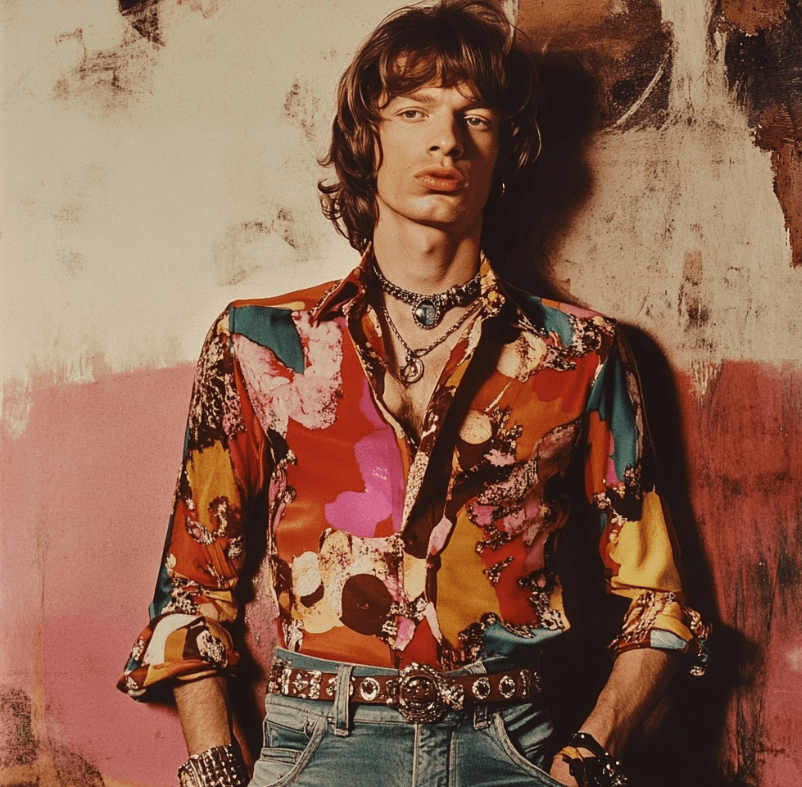
During the 1970s, the lines between formal and casual fashion became blurred. While men still wore tailored suits for formal occasions, they were often paired with colorful shirts, wide ties, and flared trousers. The traditional dark suit was replaced by brightly colored versions in shades of burgundy, mustard yellow, and even pastels. This departure from strict formalwear rules allowed men to incorporate elements of fun and playfulness into their outfits.
Key Features of 1970s Men’s Fashion
Several key elements defined the overall look of 1970s men’s fashion:
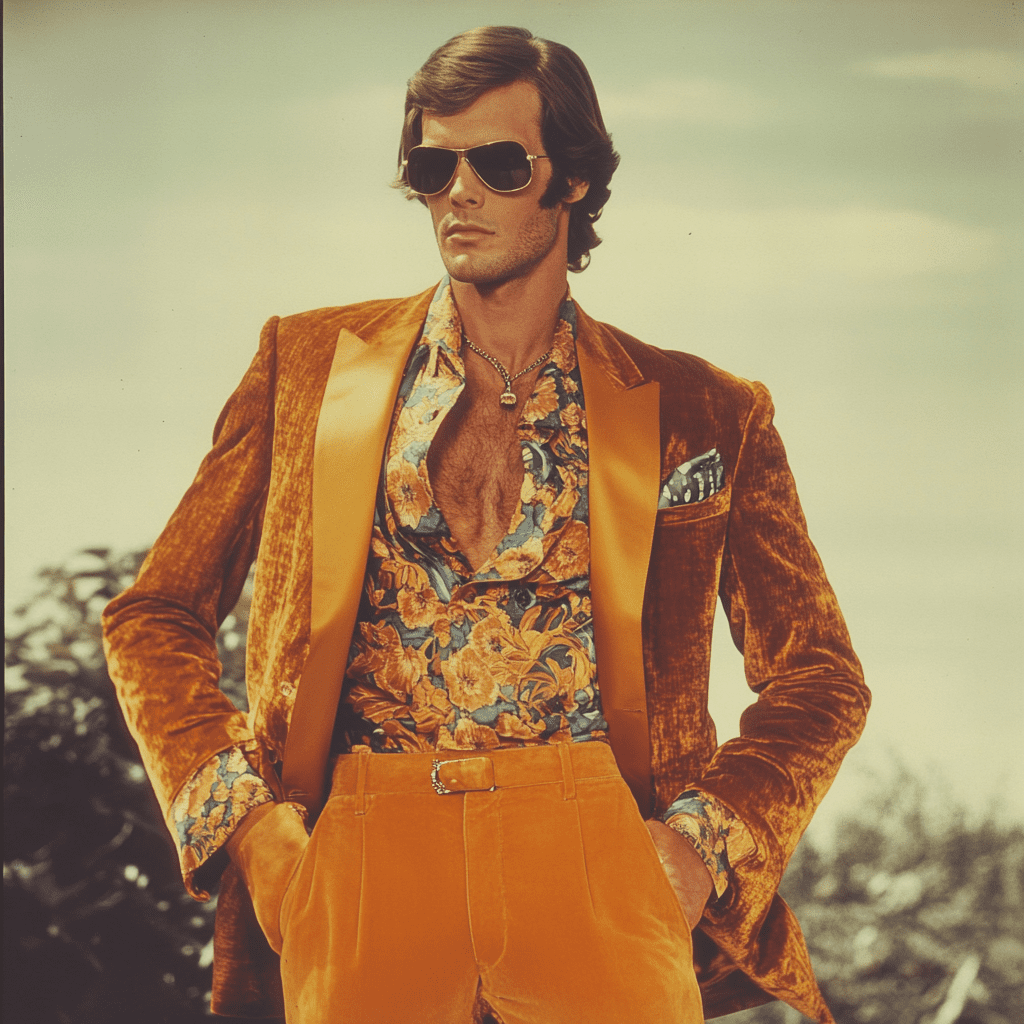
- Flared Trousers: One of the most iconic pieces of the decade, flared trousers were a staple in almost every man’s wardrobe. Whether they were worn as part of a suit or paired with a casual shirt, these wide-legged pants embodied the free-spirited nature of 1970s fashion. Flared jeans were also popular, especially among younger men, and often came in various colors and patterns.
- Wide Lapels and Collars: The 1970s are synonymous with exaggerated proportions, particularly when it came to lapels and shirt collars. Jackets, blazers, and even casual shirts featured wide lapels, while shirts often had oversized collars that were worn open at the top, exposing the chest.
- Bold Patterns and Colors: Men’s clothing during the 1970s was characterized by loud patterns like geometric shapes, paisley prints, and floral motifs. These patterns were often paired with vibrant colors like electric blue, emerald green, and burnt orange. The 1970s saw the rise of more adventurous designs, with men embracing statement pieces that reflected their personalities.
- Polyester and Synthetic Fabrics: While natural fibers like cotton and wool were still worn, polyester and synthetic fabrics became the fabric of choice for much of 1970s men’s fashion. These materials were valued for their durability, vibrant color retention, and ease of maintenance. Many men’s shirts and trousers were made from polyester blends, contributing to the sleek, shiny look that defined the disco era.
- Platform Shoes and Heeled Boots: Footwear in the 1970s was just as bold as the clothing. Men wore platform shoes with thick soles, often in patent leather or vibrant colors. Heeled boots were also fashionable, particularly when worn with flared trousers. These shoes added height and drama to outfits, perfectly complementing the wide-legged pants and flamboyant jackets.
- Casual Attire: While much of the attention on 1970s fashion is focused on bold suits and disco styles, casual wear also played an essential role in the decade’s style. Denim jackets, jeans, turtlenecks, and knit sweaters were popular choices for everyday wear. Men began to prioritize comfort and practicality in their casual wardrobes while still embracing the decade’s characteristic flair.
Disco Fashion: The Glitz and Glamour of the 1970s
Disco culture exploded in the 1970s, and the fashion associated with it became a defining element of 1970s men’s fashion. The rise of nightclubs like Studio 54 in New York City created a platform for men to embrace glamorous, daring looks while dancing the night away. The disco movement had a significant influence on mainstream fashion, leading to the adoption of shiny fabrics, bold prints, and platform shoes.
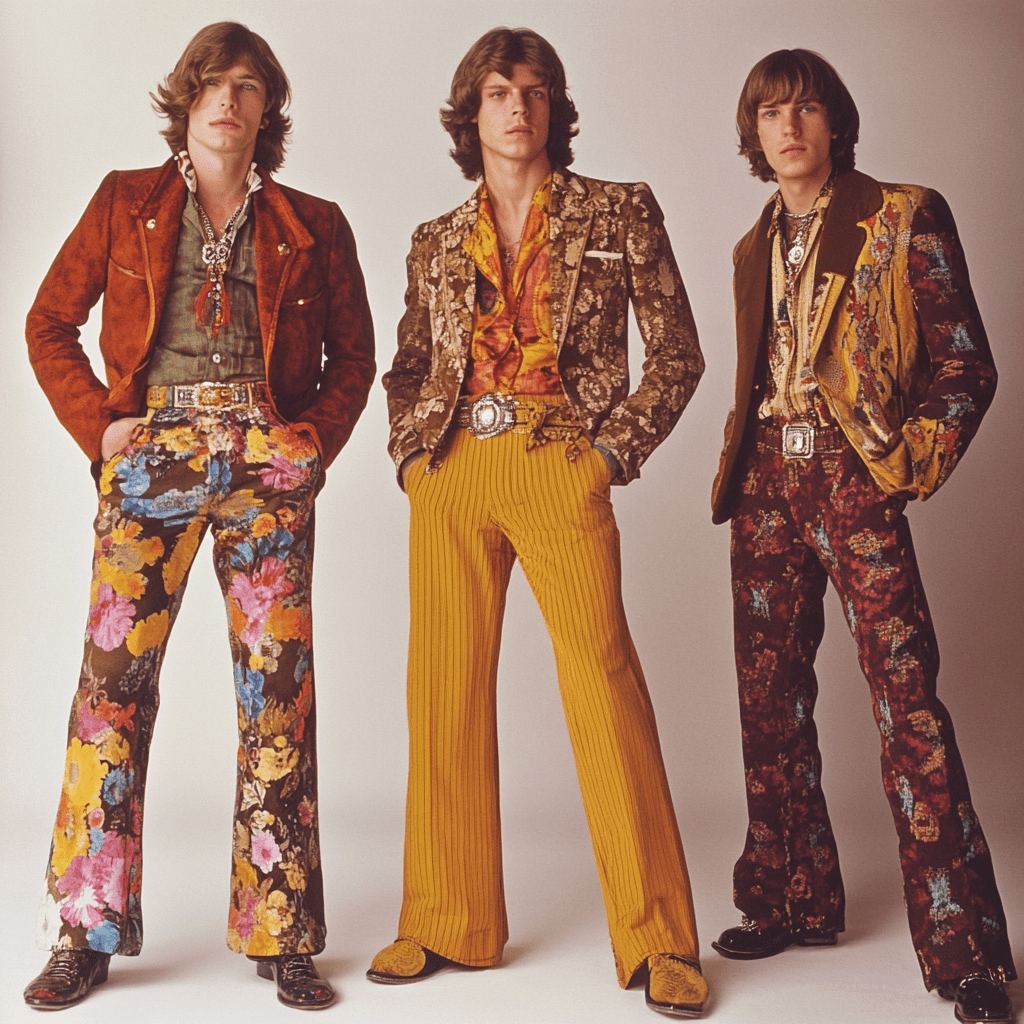
One of the key aspects of disco fashion was the use of synthetic materials like polyester, which created the sleek and shiny looks that became synonymous with the era. Disco suits for men were often three-piece suits with wide lapels and tailored trousers, paired with button-down shirts that were unbuttoned to reveal the chest. Men weren’t afraid to add a little sparkle to their wardrobes, incorporating sequins, metallic fabrics, and satin into their outfits.
The Influence of Music and Pop Culture on 1970s Fashion
Music played a pivotal role in shaping 1970s fashion for men. Beyond disco, the rise of rock, punk, and glam rock introduced a variety of alternative styles that became part of the fashion lexicon. Bands like The Rolling Stones, David Bowie, and Queen helped redefine men’s fashion, pushing boundaries with androgynous looks, flamboyant outfits, and non-traditional materials.
David Bowie, in particular, became a style icon during the 1970s. His alter ego, Ziggy Stardust, embraced glam rock fashion, which combined elements of futuristic design with over-the-top makeup and bold colors. Bowie’s influence can be seen in the adoption of metallic fabrics, platform boots, and eye-catching hairstyles among young men during the era. The rebellious nature of rock music translated into rebellious fashion choices, giving rise to styles that broke free from the norms of masculinity.
Casual 1970s Fashion: Everyday Looks for the Decade
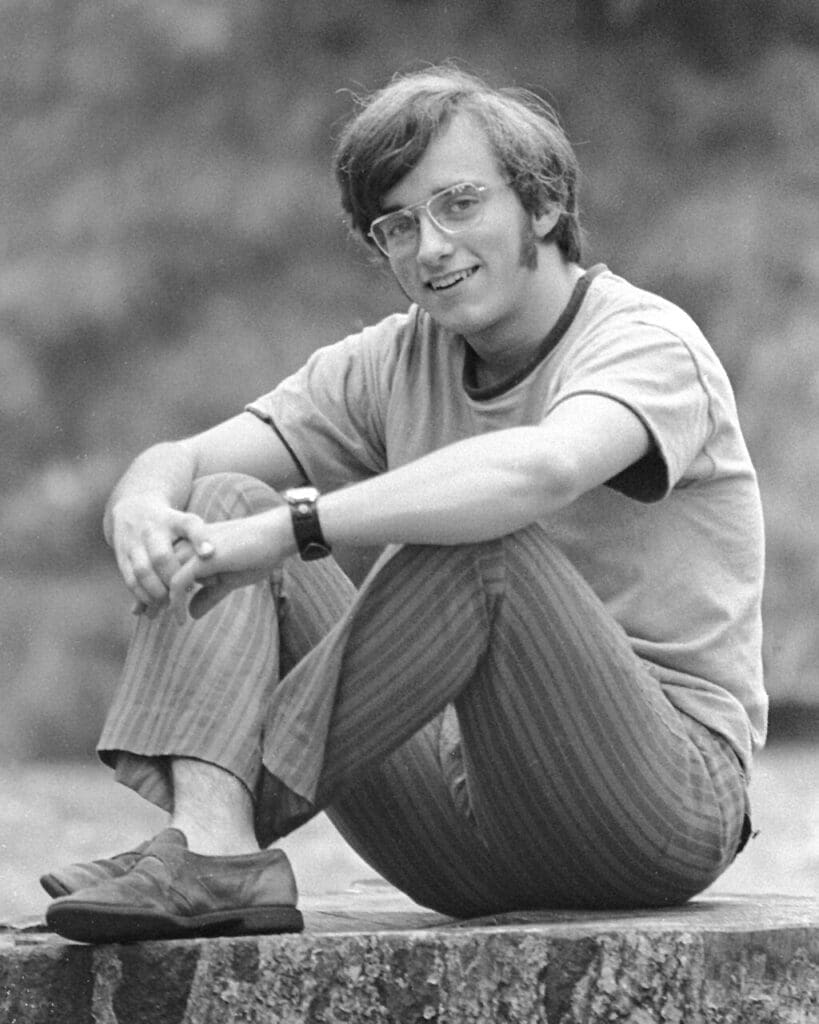
While disco and glam rock may have dominated the nightlife scene, casual fashion in the 1970s was equally important. The 1970s saw the rise of denim as a staple fabric for men, with jeans and denim jackets becoming popular pieces for everyday wear. Brands like Levi’s and Wrangler capitalized on the demand for denim, creating styles that ranged from straight-leg jeans to bell-bottoms.
Men also began to embrace sportswear-inspired looks, with track jackets, turtlenecks, and knit sweaters making their way into casual wardrobes. T-shirts with bold graphic prints became a popular form of self-expression, while aviator sunglasses and trucker hats completed the laid-back look. The focus was on creating comfortable yet stylish outfits that reflected the freewheeling spirit of the 1970s.
While the 1970s are often remembered for the glitz and glam of disco, the casual fashion of the decade had an equally significant influence on men’s style. Men’s casual wear during the 1970s was shaped by a combination of comfort, self-expression, and the relaxed attitudes of the time. Everyday 1970s fashion for men took a sharp departure from the formality of previous decades, embracing more flexible and creative approaches to clothing. Let’s explore the details of 1970s men’s casual fashion, from denim and sportswear to accessories and the men who made these trends iconic.
Denim: The Cornerstone of 1970s Casual Fashion
One of the defining elements of 1970s men’s fashion was the widespread adoption of denim as everyday wear. Jeans, which were once considered working-class clothing, became a staple for all men. Iconic brands such as Levi’s, Wrangler, and Lee introduced a range of denim styles, from the classic straight-leg cut to the more adventurous bell-bottoms, which became a hallmark of the era. Bell-bottom jeans, which flared out below the knee, were particularly associated with casual daywear and were worn by everyone from construction workers to rock stars.
In addition to jeans, denim jackets became highly popular, often paired with other casual pieces like t-shirts or button-downs. The appeal of denim was its durability and versatility, making it ideal for casual wear, workwear, and even social outings. Levi’s 501 jeans, in particular, became a cultural icon, being embraced by various subcultures, from hippies to bikers.
The Rise of Sportswear and Knitwear
The 1970s also saw the emergence of sportswear and knitwear as major components of casual men’s fashion. Track jackets, often paired with matching pants, became a favorite for casual outings. This trend was heavily influenced by the rising popularity of sports stars and a growing interest in fitness culture. Adidas and Puma became household names, with their iconic logos appearing on track suits, sneakers, and bags.
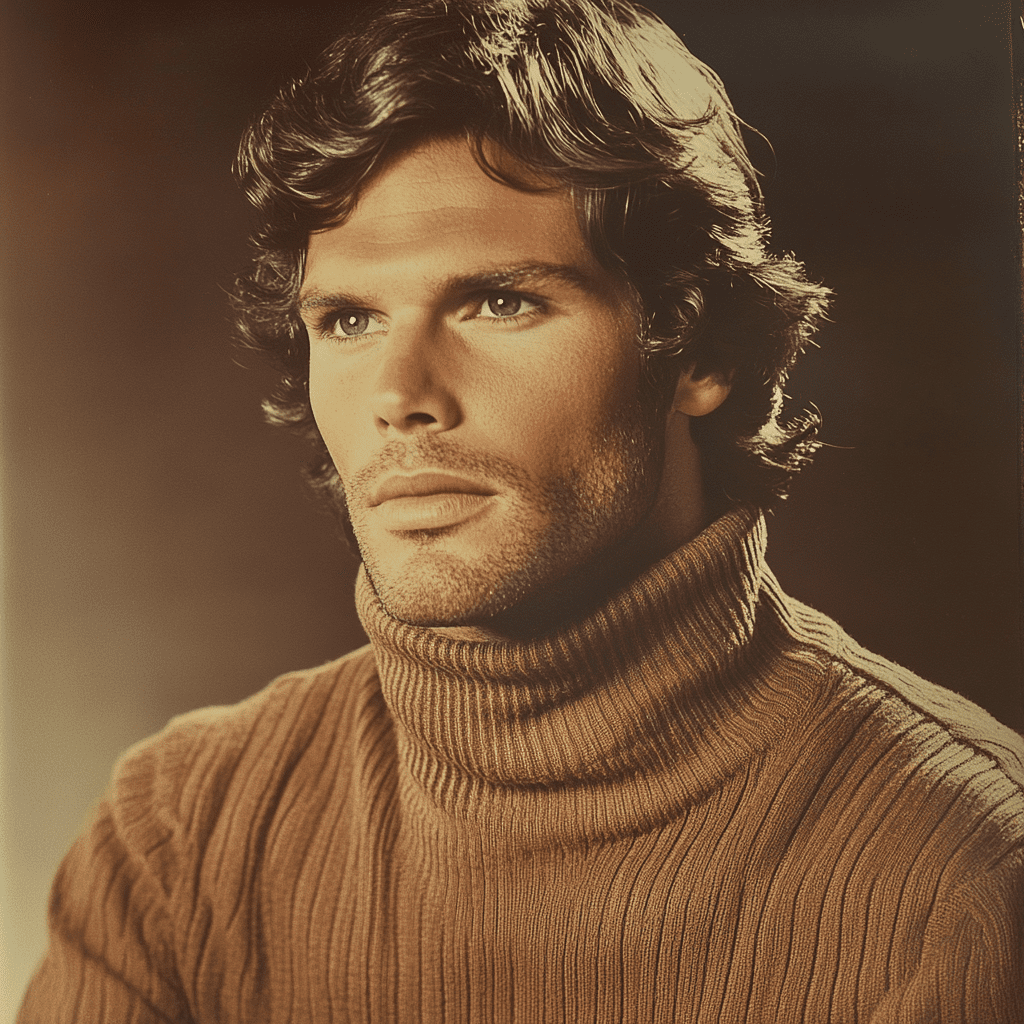
Turtlenecks and knit sweaters were also essential to casual 1970s men’s fashion. Lightweight knits were often worn with jeans or slacks, creating a stylish yet relaxed look that was both comfortable and sophisticated. Turtlenecks, in particular, became a go-to item for men looking to stay warm while maintaining a sleek appearance, often worn underneath jackets or blazers
T-Shirts and Bold Graphics
Another major trend in 1970s casual fashion for men was the rise of graphic t-shirts. Unlike the plain white t-shirts of the 1950s and 60s, 1970s graphic tees often featured bold colors, logos, slogans, and pop culture references. These shirts allowed men to express their individuality, whether it was through political messages, rock band logos, or humorous slogans. This casual, relaxed style was a stark contrast to the more structured looks of earlier decades.
Men paired their t-shirts with denim jeans or corduroy pants, further emphasizing the laid-back vibe of the time. As men’s fashion in the 1970s moved towards more casual, self-expressive styles, t-shirts became an essential item in every man’s wardrobe, cementing their place in modern fashion.
Shorts and Casual Warm-Weather Looks
When it came to warmer weather, shorts were another essential part of 1970s men’s casual fashion. Men’s shorts during this era were typically cut higher above the knee than contemporary styles, often with a straight-leg fit that provided both comfort and ease of movement. Casual shorts were paired with polo shirts, graphic t-shirts, or lightweight button-downs for an effortless look that could transition from a day at the beach to a casual weekend barbecue.
This warm-weather style became particularly popular in places like California, where the surf and beach culture influenced men’s fashion across the country. With aviator sunglasses, slip-on sandals, and light accessories, men embraced a relaxed and functional approach to everyday summer dressing.
Casual Footwear and Accessories
Accessories were an important part of 1970s men’s fashion, and the right pair of shoes or sunglasses could take a casual outfit to the next level. For footwear, sneakers dominated the scene, with brands like Converse, Adidas, and Puma leading the way. These shoes were often worn not just for sports but as casual, everyday options. Men also favored loafers, moccasins, and desert boots for a slightly more dressed-up but still casual look.
Another iconic accessory of the time was the aviator sunglasses—made famous by pop stars, Hollywood actors, and TV shows like Starsky & Hutch. These large-framed sunglasses, often with mirrored lenses, became a staple of casual fashion and are still seen as a timeless accessory today.
Casual Icons of the 1970s
Many famous men from the 1970s helped to shape and define casual fashion trends. Steve McQueen, known as the “King of Cool,” was one of the most prominent figures of 1970s men’s fashion, regularly sporting denim, turtlenecks, and aviator sunglasses. His rugged yet stylish look inspired many men to adopt more casual, functional clothing that still looked polished.
Paul Newman was another style icon, with his penchant for casual wear making him a relatable figure for men across the world. His easygoing style often featured jeans, button-downs, and sweaters, all of which contributed to his effortlessly cool image. Newman’s approach to fashion embodied the laid-back attitudes of the time, making him a definitive figure in 1970s men’s fashion.
In the world of music, David Bowie and Mick Jagger were also instrumental in defining men’s casual fashion. While both men are better known for their flamboyant stage attire, off-stage, they often embraced more understated, casual pieces such as denim jackets, graphic tees, and leather jackets. Their ability to seamlessly shift between high-fashion performance outfits and more relatable casual wear gave them a unique influence on the era’s style.
In television and film, characters from shows and movies such as Saturday Night Fever, Starsky & Hutch, and American Graffiti were often dressed in denim, t-shirts, and leather jackets, all key elements of casual 1970s men’s fashion. The characters of these media icons often influenced real-life fashion choices, as audiences sought to emulate the effortlessly cool style they saw on the screen.
Casual vs. Formal: The Lines Blur in 1970s Men’s Fashion
One of the defining features of 1970s casual men’s fashion was the blurring of lines between formal and casual wear. It became acceptable to mix traditionally formal elements, such as blazers or button-downs, with more relaxed pieces like denim jeans or turtlenecks. This shift in fashion norms was reflective of the larger cultural changes of the 1970s, where there was a move away from strict rules and towards more individual expression and freedom.
For example, men would often pair a leather jacket with wide-legged trousers, or wear a suit jacket over a graphic t-shirt. The flexibility in how clothing was styled during this decade created a wide array of casual looks that were adaptable to different settings, from a weekend barbecue to a casual Friday at the office.
Legacy of 1970s Casual Men’s Fashion
The casual fashion trends of the 1970s continue to influence modern men’s style. Many of the pieces that defined the decade, such as denim jackets, graphic t-shirts, and aviator sunglasses, remain popular today. The mix of comfort, functionality, and style that characterized 1970s casual fashion has set the tone for much of what we now consider everyday men’s fashion.
The decade’s emphasis on self-expression, individuality, and relaxed dress codes has had a lasting impact on how men approach fashion. Whether you’re looking to recreate the iconic styles of Steve McQueen or take inspiration from the everyday trends seen in Starsky & Hutch, the casual 1970s remains a goldmine for timeless fashion inspiration.
In conclusion, 1970s men’s casual fashion was a reflection of the era’s broader social movements. It embraced freedom, creativity, and the blurring of formal and casual lines. The casual looks of the time continue to resonate today, whether through denim staples, sportswear, or the lasting appeal of aviator sunglasses. As we move forward, these trends remain influential, shaping the way men dress in both everyday and more formal settings.
The Return of Suits with a Twist
Despite the casual revolution, suits remained an essential part of 1970s fashion for men. However, these were not the traditional dark, slim-fitting suits of the 1960s. Instead, 1970s suits embraced wider silhouettes, vibrant colors, and bolder patterns. The three-piece suit became a favorite for formal events, consisting of a jacket, trousers, and vest, often in matching or complementary fabrics.
For more daring fashion-forward individuals, velvet suits and printed blazers were popular choices. Some suits were designed with geometric prints, paisley patterns, or even floral designs, showcasing the decade’s flair for flamboyance. Men weren’t afraid to play with color, and shades like orange, burgundy, and olive green became popular alternatives to the more conservative colors of previous decades.
Conclusion: 1970s Fashion Men – A Decade of Diversity
The 1970s was a decade of stylistic revolution in men’s fashion, where self-expression and boldness took center stage. From the glitz and glamour of disco to the rebellious attitude of rock culture, men’s fashion embraced a wide array of influences, resulting in a decade defined by innovation and individuality. Whether dressing up for a night on the town or putting together a casual weekend look, men in the 1970s had more fashion options than ever before.
The enduring influence of 1970s men’s fashion can be seen in today’s trends, with retro-inspired styles making frequent comebacks. Flared trousers, platform shoes, and bold patterns continue to make their way onto modern runways, while vintage pieces from the 1970s remain highly sought after by fashion enthusiasts.
For those looking to embrace the spirit of 1970s men’s fashion, the key is to have fun and experiment with colors, patterns, and fabrics. The decade was all about pushing boundaries and stepping outside of traditional fashion norms, a sentiment that still resonates in contemporary style. By understanding the defining trends of the era, modern men can take inspiration from the 1970s fashion for men and incorporate elements of the past intothe modern wardrobe. In the next article, we will explore more specific aspects of 1970s men’s fashion, such as disco styles, hippie influences, and streetwear trends. Whether you’re looking for inspiration for your own style or want to learn more about the decade’s impact on fashion, the 1970s remain an iconic period for men’s fashion innovation.
Disco Fashion for Men in the 1970s: The Era of Glitter and Glam
The 1970s disco era was a cultural revolution not only in terms of music but also in fashion. Men’s fashion during the disco era was bold, extravagant, and drenched in glamour. With the rise of iconic disco clubs like Studio 54 and the booming popularity of artists like the Bee Gees and John Travolta’s Saturday Night Fever, disco fashion became synonymous with glitzy, dazzling outfits designed to capture attention under the sparkling disco ball.
This article delves into 1970s disco fashion for men, exploring the style, key elements, and the famous figures who represented this glamorous trend. Whether it was glittering jackets, platform shoes, or tight-fitting bell-bottoms, disco fashion for men was all about standing out, and its influence is still seen in modern retro-inspired looks today.
Key Elements of 1970s Men’s Disco Fashion
1. Shiny Fabrics and Bold Colors
One of the hallmarks of disco fashion for men in the 1970s was the use of shiny, eye-catching fabrics. Men embraced materials like satin, polyester, and silk, all of which shimmered under the club lights. The goal was to stand out, and these reflective fabrics did just that. Bold, vivid colors like electric blue, gold, silver, and deep red were staples of the disco wardrobe, adding vibrancy to the already eclectic styles.
2. Wide-Collared Shirts
The wide-collared shirt, often referred to as the butterfly collar, was a defining feature of 1970s men’s disco fashion. These shirts were made from shiny fabrics and often featured bold prints, geometric patterns, and bright colors. The large, pointed collars were designed to sit over jackets, ensuring they were always visible, adding to the flamboyant style. Paired with high-waisted pants, this look became iconic on the disco scene.
3. Tight-Fitting Bell-Bottoms and Flared Pants
Bell-bottoms were another quintessential element of 1970s men’s disco fashion. These pants were tight around the thighs and flared out dramatically from the knees down, creating a silhouette that was perfect for showing off dance moves on the disco floor. Popular in a range of fabrics, including polyester, satin, and even denim, bell-bottoms became a wardrobe essential for men who frequented disco clubs.
Flared pants were often paired with platform shoes, which were essential for both height and style. Platform shoes, often several inches tall, were adorned with vibrant colors and patterns, adding to the extravagant look that dominated the disco era. The taller, the better, as men aimed to reach new heights—literally and figuratively—on the dance floor.
The Influence of Celebrities and Movies on 1970s Disco Fashion
Disco fashion in the 1970s wasn’t just limited to the clubs—it was also shaped by some of the biggest stars of the time. Famous men in music and film were instrumental in defining and popularizing the trends that dominated this glittering era.
John Travolta – Saturday Night Fever (1977)
Perhaps the most iconic figure associated with disco fashion for men in the 1970s is John Travolta, thanks to his portrayal of Tony Manero in the 1977 movie Saturday Night Fever. The film, which centered around a young man’s love for disco dancing, showcased some of the most enduring looks of the era. Tony Manero’s signature white polyester suit with wide lapels and high-waisted bell-bottom trousers became an instant fashion sensation. Paired with a black shirt and platform shoes, Travolta’s look in Saturday Night Fever became synonymous with the disco era and remains one of the most recognizable fashion moments in film history.
The Bee Gees – Kings of Disco Music and Style
The Bee Gees, whose music defined the soundtrack of the disco era, were also major style icons of the time. Brothers Barry, Robin, and Maurice Gibb embraced the disco fashion trends with their signature tight shirts, wide-collared jackets, and bell-bottom trousers. They often wore sparkling jumpsuits and satin shirts, accentuated by bold patterns and glittering fabrics. The Bee Gees’ style was reflective of their music—extravagant, fun, and perfectly suited for the high-energy world of disco.
Their iconic outfits, often made from polyester and silk, were tight-fitting to emphasize movement and style. The Bee Gees set the trend for disco men’s fashion, especially with their memorable looks on album covers and performances. Their disco ballad “Stayin’ Alive” became a cultural anthem, and so did their style, which was all about swagger, attitude, and sparkle.
Elton John – The Master of Glam Disco Fashion
Another unforgettable figure in 1970s men’s disco fashion was Elton John. Known for his bold and flamboyant sense of style, Elton John frequently wore platform shoes, glittering jackets, and oversized sunglasses, all of which became emblematic of the disco era’s love of excess. His performances were as much about fashion as they were about music, and his outlandish, over-the-top outfits became a major influence on men’s disco fashion.
John’s use of sequins, glitter, and shiny materials helped solidify his place as a disco fashion icon, and his look was embraced by men seeking to express themselves in creative and extravagant ways. His stage outfits often featured feather boas, bright metallic colors, and bedazzled sunglasses, representing the essence of disco’s exuberant aesthetic.
David Bowie – Glam Rock Meets Disco
Though primarily known for his contributions to glam rock, David Bowie was also an influential figure in disco fashion for men. His alter ego Ziggy Stardust introduced the world to bold, gender-fluid fashion that embraced androgyny, sequins, and glitter—all elements that would go on to influence disco fashion. Bowie’s daring wardrobe, including glittering jumpsuits, platform boots, and metallic suits, helped merge the worlds of glam rock and disco, creating a fashion crossover that defined much of the 1970s.
Disco Fashion in 1970s Pop Culture
Disco fashion for men wasn’t just confined to the dance floor—it made its way into all forms of pop culture, including music, film, and television.
Studio 54 was the epicenter of the disco scene and was known as a place where fashion met celebrity. Celebrities, models, musicians, and everyday club-goers flocked to Studio 54 wearing their best disco-inspired outfits. It wasn’t uncommon to see men dressed in glittering jackets, satin shirts, and flared pants. Studio 54, with its hedonistic parties and star-studded guest list, became a cultural touchstone for the decade, representing the height of 1970s disco fashion.
Films like Thank God It’s Friday and shows like Soul Train helped spread the popularity of disco fashion. Soul Train, in particular, was instrumental in showcasing the latest disco fashion for men through its dancers and musicians. The show brought disco style to mainstream America, featuring men in bold, colorful suits, wide-collared shirts, and statement accessories like gold chains and aviator sunglasses.
Key Accessories for Men in 1970s Disco Fashion
Accessories played an essential role in completing the disco look for men in the 1970s. Some of the most popular accessories included:
- Gold Chains: No disco look was complete without a gold chain or medallion. Worn over wide-collared shirts, these chains became a status symbol, adding to the glitzy, glamorous look.
- Aviator Sunglasses: Made famous by celebrities like Elton John and actors in disco-era films, aviator sunglasses were often worn at night in clubs. These oversized glasses added an air of mystery and style to any disco outfit.
- Platform Shoes: Perhaps one of the most recognizable accessories of the 1970s, platform shoes were worn by both men and women in the disco scene. These shoes often featured brightly colored or patterned materials and added a sense of height and drama to the disco look.
- Floppy Hats and Fedoras: Hats became a popular accessory for men in the disco scene, adding a touch of flair and personality to the overall outfit. Often paired with flared pants and wide-collared shirts, these hats completed the glamorous, laid-back disco style.
Legacy of 1970s Disco Fashion for Men
Though the disco era came to an end by the early 1980s, its fashion legacy endures. The extravagant style of 1970s disco mens fashion has experienced several revivals in the decades since, influencing modern fashion trends, particularly in the realms of music and entertainment. Many designers have drawn inspiration from the disco era’s bold use of color, sequins, and flamboyant silhouettes.
Disco fashion for men in the 1970s was about more than just clothes—it was a cultural statement, a symbol of freedom, excess, and exuberance. Whether on the dance floor or the silver screen, 1970s men’s disco fashion continues to inspire and captivate audiences today.
In conclusion, the disco fashion trends of the 1970s for men were rooted in flamboyance, glitter, and the desire to stand out. From platform shoes to wide-collared shirts and bell-bottom trousers, this era was defined by its bold fashion choices. Theflamboyant style of the disco era had a lasting impact on the fashion world. Famous men from pop culture and movies, such as John Travolta, Elton John, and The Bee Gees, helped to define and popularize the signature disco looks of the time. Their glamorous outfits, glittering fabrics, and bold accessories continue to be emulated and celebrated in modern fashion, showing how influential 1970s men’s disco fashion remains.
Disco Fashion for Men in the 1970s: Key Elements Recap
- Shiny Fabrics & Bold Colors: Eye-catching satin, polyester, and silk in vibrant hues.
- Wide-Collared Shirts: The butterfly collar became a defining look of the era.
- Bell-Bottoms & Flared Pants: Tight-fitting around the thighs, flaring dramatically to the knees.
- Platform Shoes: Adding height and personality to every disco ensemble.
- Accessories: Gold chains, aviator sunglasses, and hats completed the outfits, elevating the style of the disco man.
Whether you’re looking to channel the swagger of Tony Manero or the glamour of Elton John, disco fashion remains an iconic moment in men’s fashion history. Its influence continues to inspire modern trends, and its legacy lives on in fashion, film, and music. The glitter and glamour of 1970s disco fashion for men will forever be remembered as one of the boldest and most vibrant fashion eras in history.
Black Men’s Fashion in the 1970s: Style and Culture
The 1970s was a pivotal decade for Black men’s fashion, a time when style was not only a reflection of personal taste but also a cultural statement. From the smooth sophistication of the Motown era to the flamboyant styles of the disco movement, Black men in the 1970s were at the forefront of pushing fashion boundaries. Their influence helped shape broader trends in American and global fashion, blending African cultural elements with bold, avant-garde designs that were expressive of the times.
Key Influences on Black Men’s Fashion in the 1970s
Black men’s fashion during the 1970s was deeply rooted in cultural movements. The decade saw the rise of African-American pride and self-expression, and this was reflected in the fashion choices of many Black men. Inspired by the Civil Rights Movement, the Afrocentric movement, and the emerging Black Power Movement, Black men’s fashion became a way to celebrate their identity and resist mainstream narratives.
- Afro Hair and Natural Styles One of the most iconic symbols of Black identity in the 1970s was the Afro, a natural hairstyle that gained popularity alongside the Black Power Movement. Worn proudly by influential figures such as activists Huey Newton and Angela Davis, the Afro became a powerful political statement of Black pride. For Black men, wearing an Afro was not just a fashion choice but also an act of resistance against societal pressures to conform to Eurocentric beauty standards.
- Dashikis and African-Inspired Fashion The 1970s also saw a rise in Afrocentric fashion, with Black men embracing clothing inspired by traditional African designs, such as the dashiki. Dashikis, brightly colored tunics with embroidered details, became a popular choice for Black men seeking to connect with their African roots. Artists and entertainers such as James Brown and Muhammad Ali were often seen sporting these garments, solidifying them as fashionable yet deeply symbolic attire.
- Soul and Funk Fashion The music and entertainment industry had a profound influence on Black men’s fashion in the 1970s. As soul music and funk gained popularity, the styles of performers became cultural markers. Artists like Marvin Gaye, Isaac Hayes, and Sly Stone popularized flamboyant and flashy outfits. Bold patterns, bright colors, wide-collared shirts, and platform shoes were all staples of this style. Men’s suits in this era often featured wide lapels, bell-bottom trousers, and loud colors that matched the energy of the music and culture.
- Disco Fashion The disco movement, which took off in the latter half of the decade, also had a significant influence on Black men’s fashion. Disco styles embraced glitter, bold patterns, and vibrant colors. Many Black men, especially those seen in the vibrant nightlife scenes of cities like New York and Chicago, embraced the glitzy style. Platform shoes, bell-bottom pants, and wide-collared shirts were popular staples among men on the dance floors of famous clubs like Studio 54.
Notable Icons of 1970s Black Men’s Fashion
Many influential figures helped shape the fashion of the 1970s for Black men. Whether through music, movies, or activism, these individuals left an indelible mark on fashion.
- Richard Roundtree: Known for his role as private detective John Shaft in the movie Shaft (1971), Roundtree’s stylish trench coats, leather jackets, and turtlenecks became synonymous with Black cool. The character of Shaft embodied the confident, fearless, and stylish Black man, and the movie helped popularize urban streetwear in mainstream fashion.
- James Brown: As the “Godfather of Soul,” James Brown not only influenced music but also men’s fashion with his elaborate, colorful outfits. He often sported wide-collared shirts, tight-fitting pants, and bold colors that were part of the burgeoning funk scene. Brown’s bold wardrobe choices inspired generations of men to take risks with fashion and embrace their unique style.
- Marvin Gaye: Marvin Gaye’s sleek yet relaxed style reflected the smooth sounds of his music. His fashion was a blend of casual elegance—think tailored suits paired with turtlenecks or bell-bottoms. Gaye’s fashion choices perfectly embodied the sophistication of soul music, and his laid-back, yet polished look became a staple of the era.
- Muhammad Ali: The legendary boxer Muhammad Ali not only dominated the ring but also commanded attention outside of it with his fashion choices. His Afrocentric styles, including dashikis, paired with his natural Afro, made him a symbol of Black pride and excellence. Ali’s charisma and unapologetic style choices left a lasting legacy in both sports and fashion.
Everyday 1970s Fashion for Black Men
While the bold disco styles often made headlines, everyday fashion for Black men in the 1970s was a mix of comfort, cultural pride, and emerging trends. Key staples included:
- Denim: Jeans, often paired with denim jackets, were a casual essential. Brands like Levi’s and Wrangler became household names as denim became more accessible and popular for day-to-day wear.
- Turtlenecks and Sweaters: Knitwear became a go-to choice for many men. Turtlenecks, in particular, were worn underneath jackets for a clean yet stylish look. Paired with high-waisted trousers, these looks were both fashionable and functional.
- Tracksuits and Sportswear: As sportswear became a part of casual fashion, tracksuits, and sneakers gained popularity. In urban areas, Adidas sneakers became iconic, thanks to their popularity in the growing hip-hop scene of the late 1970s and early 80s.
- Platform Shoes: Even in everyday settings, platform shoes were a staple for many Black men. These shoes added a bold touch to otherwise casual outfits and became a key element of 1970s footwear.
The Impact of Film and Television on 1970s Black Men’s Fashion
Popular culture played a crucial role in shaping fashion trends for Black men in the 1970s. The Blaxploitation film genre, in particular, presented Black actors in leading roles, often portraying them as strong, independent figures with impeccable style.
- Shaft (1971): Richard Roundtree’s portrayal of Shaft brought urban Black men’s style to the forefront. Shaft’s iconic look—leather jackets, turtlenecks, and tailored pants—became synonymous with the tough, stylish man who was in control of his world. Shaft wasn’t just a hero in action but also in fashion, embodying a style that resonated with the Black community.
- Super Fly (1972): Super Fly starred Ron O’Neal as Youngblood Priest, a suave cocaine dealer who wore sharply tailored suits, wide-brimmed hats, and fur-trimmed coats. His flamboyant style, particularly his elaborate suits, became a fashion statement that transcended the silver screen and entered everyday Black men’s fashion. Priest’s style symbolized luxury, power, and rebellion, and it influenced trends both in and out of urban communities.
The Legacy of 1970s Black Men’s Fashion
The influence of Black men’s fashion from the 1970s continues to resonate in modern style. The era’s bold, confident choices can be seen today in contemporary streetwear, hip-hop fashion, and high fashion runway shows. Modern designers often draw inspiration from the styles that were pioneered by Black men during this era.
- Afrocentric fashion: The dashiki, once a symbol of African pride in the 1970s, continues to influence fashion designers who embrace the fusion of traditional African prints with modern styles. Celebrities like Kanye West and Jidenna have incorporated Afrocentric elements into their wardrobes, paying homage to the 1970s movement.
- Funky, retro-inspired looks: From oversized collars to flared pants, many fashion trends from the 1970s have made a comeback. Influences from the funk and soul scenes are evident in today’s fashion, with the use of vibrant colors, patterns, and wide-leg trousers that echo the disco era.
Conclusion
Black men’s fashion in the 1970s was more than just a trend—it was a cultural movement. From the Afro and dashiki to the sharp suits and flamboyant disco attire, Black men embraced fashion as a form of self-expression, identity, and pride. Influenced by music, film, and the social changes of the time, the 1970s left a lasting impact on Black men’s fashion, one that continues to inspire modern trends and celebrates the vibrant, diverse history of Black style.
Hippie 1970s Fashion for Men: The Bold and Free-Spirited Look
The 1970s was a decade defined by its counterculture movements, and few had as much lasting influence on fashion as the hippie movement. For men in the 1970s, the hippie style was more than just a fashion choice; it was an expression of personal freedom, rebellion, and anti-establishment values. The free-spirited ethos of the 1960s spilled over into the 1970s, and men’s hippie fashion embraced elements of nature, individuality, and nonconformity. This fashion style was bold, eclectic, and often mixed with Eastern influences and a “back to the earth” philosophy.
The Origins of Hippie Fashion for Men
The hippie movement began in the 1960s as a response to social upheavals, including opposition to the Vietnam War, civil rights activism, and a growing sense of disillusionment with mainstream society. By the 1970s, the hippie movement had evolved, and so had the fashion that was integral to its identity. Hippie men’s fashion reflected the desire to break away from the traditional norms of the 1950s and early 60s, where men wore conservative suits and ties. In contrast, 1970s hippie fashion was all about breaking boundaries, embracing color, and incorporating ethnic and Bohemian influences.
Essential Elements of 1970s Hippie Fashion for Men
1. Bell-Bottoms and Flared Pants Perhaps the most recognizable item of 1970s hippie men’s fashion was the bell-bottom. Bell-bottom pants flared out dramatically at the bottom, creating a look that was both bold and flowy, reflecting the free spirit of the era. Worn in a variety of fabrics, from denim to corduroy, bell-bottoms were paired with everything from tunics to simple t-shirts. This style symbolized a departure from the conservative dress codes of previous decades and embraced movement and comfort.
Famous men wearing bell-bottoms: Musicians like Jimi Hendrix and Mick Jagger often sported bell-bottoms on stage, making the trend mainstream for men with a rebellious edge.
2. Tie-Dye Shirts The tie-dye shirt is an iconic staple of hippie fashion and perfectly encapsulates the free-spirited, DIY ethos of the movement. Tie-dye became synonymous with individuality, as no two shirts were ever alike. The shirts were often handmade, using vibrant colors like orange, blue, yellow, and green, creating swirling, psychedelic patterns.
Cultural influence: Tie-dye gained popularity as part of the Woodstock generation and was associated with the laid-back, peace-and-love vibe of the time. Bands like The Grateful Dead and Janis Joplin (though a woman) helped spread tie-dye across the countercultural scene.
3. Fringe and Suede Fringe was another key component of 1970s hippie fashion for men, often seen on jackets, vests, and even pants. Suede fringe jackets were a favorite, combining Native American-inspired fashion elements with the rebellious spirit of the hippie movement. Men paired these fringe jackets with bell-bottoms or jeans, creating a look that was rugged yet stylish.
Famous figures: Jim Morrison of The Doors and actors like Peter Fonda in Easy Rider popularized this Western, fringe-laden style. These men embodied the rugged individualism that the 1970s counterculture celebrated.
4. Long Hair and Headbands Hair became an essential part of men’s fashion in the 1970s hippie movement. Long, natural hair was a symbol of rebellion against societal norms that dictated men keep their hair short and well-groomed. Hippie men grew their hair long and unkempt as an act of resistance and to align with the naturalistic values of the movement.
Headbands became a signature accessory, not only to keep long hair in place but also as a stylish symbol of countercultural identity. The headbands were often made from natural materials like leather or adorned with beads.
Cultural relevance: Icons such as John Lennon and George Harrison wore their hair long during the height of The Beatles’ influence, making long hair and headbands staples of the 1970s hippie aesthetic.
5. Ethnic and Eastern-Inspired Clothing Hippie men’s fashion often incorporated clothing that drew inspiration from non-Western cultures, particularly from India and Africa. Dashikis, flowing kaftans, and kurta shirts became popular among hippie men who embraced Eastern spirituality and the quest for peace and enlightenment.
These items were loose, comfortable, and often made from natural fabrics like cotton or hemp, further embodying the movement’s back-to-nature ideals. Indian-inspired patterns, like paisley and mandalas, became part of the vibrant prints worn by men in the hippie subculture.
Eastern influence: The growing popularity of transcendental meditation, yoga, and Eastern philosophy (popularized by figures like George Harrison) contributed to the fashion choices of hippie men, who adorned themselves in these flowing garments as a reflection of their spiritual journey.
Icons of 1970s Hippie Fashion for Men
Numerous cultural icons from the 1970s helped define hippie fashion for men. These figures not only represented the clothing styles but also the spirit of the movement itself.
- Jimi Hendrix: One of the most influential guitarists of all time, Hendrix was also a style icon. His signature look included wild, colorful patterns, open shirts, and a mix of military-inspired jackets paired with fringes and headbands. Hendrix’s larger-than-life persona was perfectly reflected in his eclectic, free-spirited wardrobe.
- John Lennon: By the 1970s, Lennon had embraced the peace-and-love movement, wearing everything from tie-dye shirts to fur coats and ethnic tunics. His long hair and round, wire-frame glasses also became synonymous with the counterculture, influencing both music and fashion.
- Jim Morrison: Known for his rock-star swagger, Morrison of The Doors was often seen in tight leather pants, suede jackets, and oversized belts with bohemian touches. His wild, untamed look, paired with his long hair, captured the rebellious spirit of the 70s counterculture.
- Peter Fonda: As the star of the cult classic Easy Rider (1969), Fonda helped bring biker and hippie fashion into the mainstream. His character’s laid-back, fringe leather jackets and worn denim jeans became an iconic look associated with the free-spirited traveler and anti-establishment figure of the time.
- David Crosby: As part of the supergroup Crosby, Stills, Nash & Young, Crosby’s style was rooted in natural fabrics, comfortable jeans, and flowing tunics. His earthy style mirrored the folk and country influences of the band and the peaceful rebellion of the hippie movement.
The Connection Between Hippie Fashion and Social Movements
The fashion choices of hippie men in the 1970s were deeply tied to the cultural and political shifts of the time. The clothing wasn’t just about appearance—it was a reflection of broader ideals like peace, anti-materialism, and environmentalism. Men wearing loose, comfortable clothing, rejecting mainstream fashion, and opting for second-hand or handmade pieces was symbolic of the broader rejection of capitalism and consumer culture.
Fashion in the 1970s was about authenticity, individuality, and rejecting the pressures of the corporate world. It was about embracing nature, Eastern philosophies, and alternative lifestyles.
Conclusion: The Lasting Legacy of Hippie Fashion for Men
Even though the 1970s have long since passed, the influence of hippie fashion on men’s style remains strong. The carefree spirit, bold patterns, and rejection of traditional menswear have influenced modern trends. From the resurgence of tie-dye shirts in streetwear to modern interpretations of flared pants and natural fabrics, the bold and free-spirited look of 1970s hippie fashion for men continues to inspire designers and trendsetters alike.
The 1970s were a time of liberation and self-expression, and the clothing worn by men during this era reflected that. The bold choices of the hippie movement still resonate in fashion today, making it a timeless style that represents not only an aesthetic but also a way of life.
Summer Fashion in the 1970s for Men: Styles to Beat the Heat
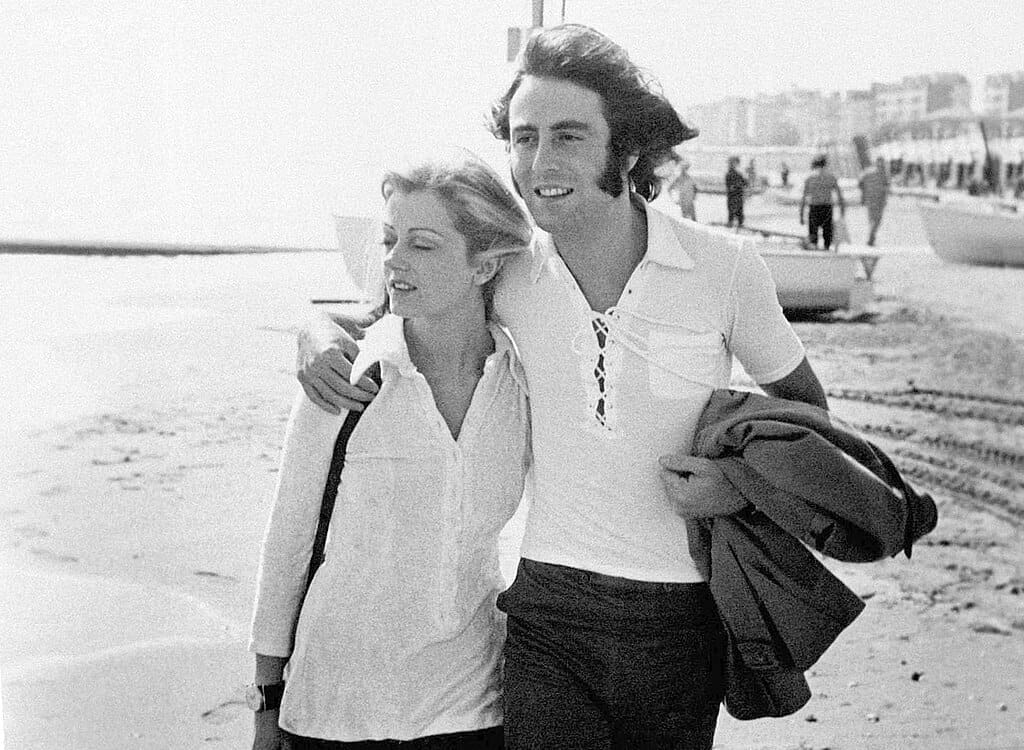
The 1970s was an era defined by bold self-expression and experimentation in men’s fashion, and summer wear was no exception. As temperatures rose, men’s fashion in the 70s saw a transformation that balanced comfort and style with the same flamboyance that characterized the decade.
Summer wardrobes were full of colorful patterns, lightweight fabrics, and relaxed silhouettes that embraced the freedom and liberation of the time. Below, we dive into the trends that dominated 1970s men’s summer fashion, focusing on the styles and cultural icons who defined these looks.
The Essential Elements of 1970s Men’s Summer Fashion
1. Lightweight Fabrics and Loose Silhouettes The heat of the summer in the 1970s meant that men’s fashion had to be light and breathable. Natural fabrics like cotton, linen, and lightweight denim became staples of the summer wardrobe. Men favored shirts that were loose-fitting and made from breathable materials to stay cool in the sun. The idea was to embrace a relaxed silhouette, allowing air to circulate and providing ease of movement.
- Examples:
- Loose, button-down shirts in solid colors or floral patterns.
- Linen trousers or lightweight bell-bottom jeans.
- Iconic loose-fitting tops often made from jersey fabric.
2. Color and Patterns As with the rest of 1970s fashion, summer style embraced color and patterns in bold, eye-catching ways. Bright colors like orange, yellow, and green were common, along with tropical patterns such as floral prints, abstract shapes, and geometric designs. These prints were frequently seen on shirts, swimwear, and even tailored summer suits.
- Floral shirts: These shirts, often short-sleeved and made of cotton or polyester blends, were staples for a casual day at the beach or a summer BBQ.
- Polka dots and psychedelic prints: Drawing on the influence of the hippie movement and disco culture, these patterns added flair to summer clothing.
3. Shorts: A Bold New Length Shorts became increasingly popular for men in the 1970s, moving away from the knee-length styles of previous decades to much shorter, more revealing options. Short shorts, often made from materials like nylon or denim, allowed men to show more skin and move freely. Paired with tank tops or open shirts, shorts became a key element of casual summer wear.
- Styles:
- Cut-off denim shorts: These were particularly popular in casual, laid-back settings. Whether at music festivals or just hanging out, men embraced a DIY approach by turning their old jeans into stylish cut-offs.
- Athletic-style shorts: Nylon shorts, sometimes with a slight flare, were perfect for outdoor sports or a casual summer look.
4. Summer Footwear When it came to footwear, men in the 1970s embraced sandals, loafers, and casual sneakers. Leather sandals and flip-flops were essential for beach trips, poolside lounging, or a casual day in the sun. On the other hand, if men wanted a dressier look, they opted for loafers with no socks.
- Popular choices:
- Birkenstocks: These comfortable sandals became highly popular, embodying the bohemian and naturalistic spirit of the decade.
- Canvas sneakers: Shoes like Converse All Stars became synonymous with casual summer fashion, providing a cool yet relaxed look.
5. Tank Tops and Sleeveless Shirts As temperatures climbed, men opted for tank tops and sleeveless shirts that offered comfort and style. Popular in both casual and athletic wear, these tops were often adorned with bold graphics, sports team logos, or simple block colors. Tank tops were perfect for showing off that 70s beach body, and their practicality made them a must-have for summer wardrobes.
- Pop Culture Influence: The trend of sleeveless shirts was often associated with actors like John Travolta, who rocked tight-fitting tanks in movies like Saturday Night Fever.
Influential Figures and Pop Culture Icons Who Defined 1970s Men’s Summer Fashion
Many pop culture figures played a significant role in shaping summer fashion in the 1970s, from musicians to movie stars.
- John Travolta: As the face of disco and the star of Saturday Night Fever, Travolta’s style influenced the mainstream, and his summer looks often involved tight-fitting shirts, slim trousers, and flashy accessories that exuded confidence and flair.
- Robert Redford: Known for his rugged good looks and timeless style, Redford often embraced laid-back summer looks in movies like Three Days of the Condor and The Way We Were. His go-to looks included casual button-down shirts, khakis, and loafers, embodying the effortless cool of summer style.
- Elton John: Though known for his eccentric fashion, Elton John influenced summer fashion by incorporating bold patterns, sunglasses, and extravagant accessories into his outfits. His colorful stage outfits and playful approach to fashion inspired men to take more risks with their summer wardrobes.
- The Bee Gees: As disco took over the world, the Bee Gees became fashion icons. Their outfits featured unbuttoned shirts, gold medallions, and flared trousers, which were perfect for hot summer nights spent dancing.
- David Bowie: A true fashion chameleon, Bowie’s androgynous and daring style influenced men’s summer fashion in the 70s. His love for bright colors and nonconformist looks encouraged many to experiment with bold, eye-catching pieces.
Summer Suits and Beachwear: The Sophisticated Side of 1970s Summer Fashion
While much of the 1970s men’s summer fashion embraced casual styles, there were also more refined summer looks for formal occasions or summer holidays. Summer suits made from linen or lightweight cotton became popular for summer events like garden parties or weddings. These suits often came in light colors like beige, white, or light blue, offering a cool and comfortable alternative to traditional wool suits.
- Safari Suits: Inspired by colonial military uniforms, safari suits became a fashionable choice for men during the summer months. These suits featured short-sleeved jackets and matching shorts, often worn with a belt. Safari suits were the epitome of laid-back, yet sophisticated, summer dressing.
- Swimwear: For beachwear, speedos or shorter swim trunks were popular. Swimwear often featured bold patterns or stripes and reflected the desire for freedom and liberation in both movement and style.
Famous 1970s Summer Fashion Movies and Television
The 1970s was a golden age for cinema, and summer fashion trends were reflected in some of the most iconic films and television shows of the era. From beach party movies to action-packed adventures, Hollywood embraced 70s summer fashion.
- Grease (1978): The iconic musical, starring John Travolta as Danny Zuko, captured many summer looks of the 1950s, but the film’s success in the 70s brought a renewed interest in retro summer fashion. Danny’s leather jacket and white t-shirt combo, alongside colorful outfits from the supporting characters, made it a summer favorite.
- Saturday Night Fever (1977): Although known for its nightlife fashion, Saturday Night Fever influenced daytime summer fashion as well. Men took inspiration from Travolta’s tight-fitting shirts, trousers, and slick style for casual summer looks.
- Endless Summer (1966): Though released a few years before the 70s, this surf documentary helped to shape the laid-back surfer style that continued into the next decade. Men’s fashion drew heavily from the beach culture featured in the film, with board shorts, loose tank tops, and unbuttoned Hawaiian shirts becoming popular.
Conclusion: A Decade of Summer Fashion Freedom
Summer fashion in the 1970s for men was all about embracing freedom—both in terms of style and self-expression. Whether it was bold prints, vibrant colors, or daring cuts, men were no longer confined to traditional fashion norms. The summer wardrobe of the 1970s offered versatility, blending comfort and style with a touch of rebellion.
From loose, colorful shirts and short shorts to sophisticated linen suits, 1970s summer fashion allowed men to feel both cool and stylish under the sun. The cultural icons of the time, including musicians, movie stars, and public figures, played a pivotal role in shaping the trends that defined the decade’s summer style. Today, many of these trends have made a comeback, proving that the 1970s men’s summer fashion remains a timeless and influential era in the world of style.
The Best 1970s Fashion Outfits for Men: Timeless Retro Styles
The 1970s marked a significant period in men’s fashion, characterized by bold experimentation, freedom of expression, and a mix of influences from various subcultures. From streetwear to formal attire, the decade was all about pushing boundaries and creating new aesthetics. Whether inspired by the disco scene, hippie movement, or classic retro looks, 1970s outfits for men embraced the era’s spirit of individuality.
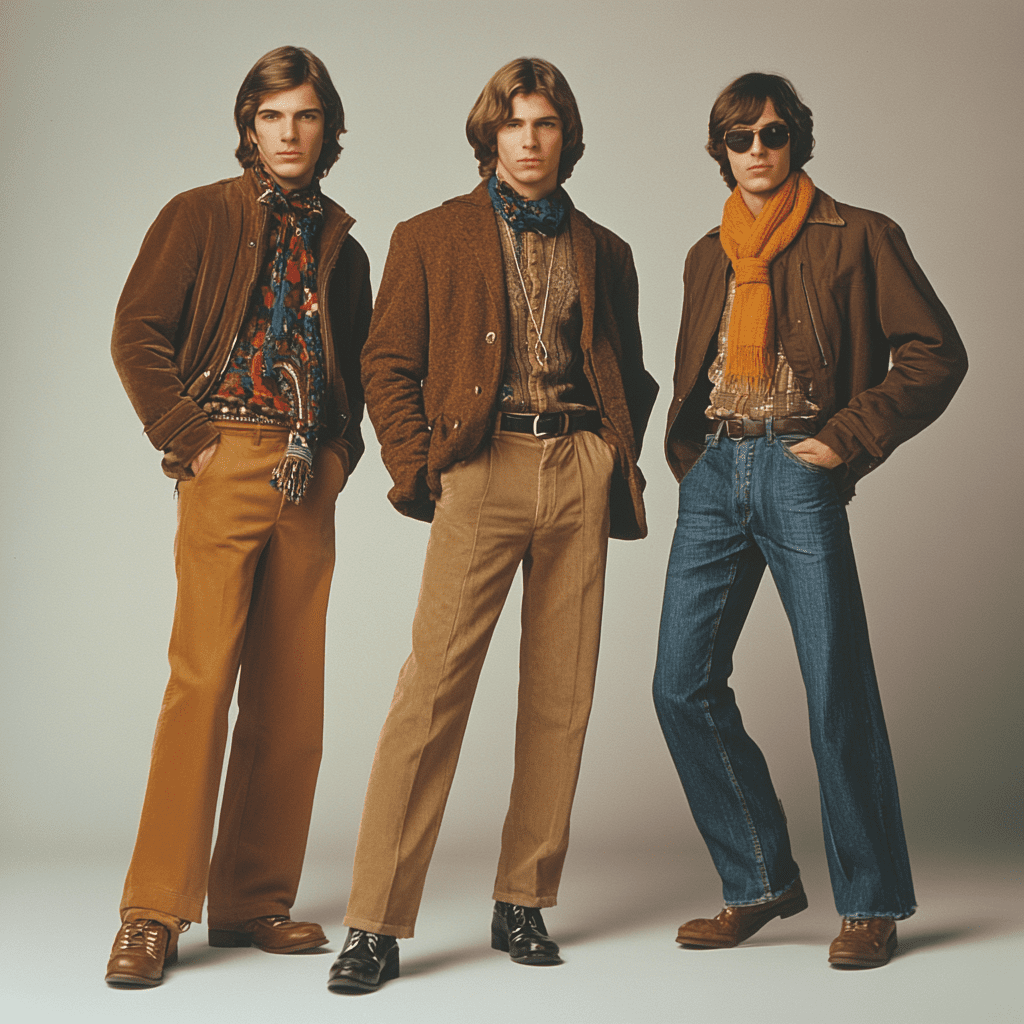
Today, the appeal of 1970s retro fashion remains strong, with many iconic styles making a comeback. Let’s dive into some of the best 1970s fashion outfits for men, exploring both casual streetwear and more formal looks.
1. The Statement Suit: Bold Colors and Wide Lapels
One of the standout elements of men’s fashion in the 1970s was the bold, brightly colored suits that dominated the era. These suits were often tailored with exaggerated features like wide lapels, flared trousers, and double-breasted jackets. While past decades favored more conservative tones, the 1970s embraced loud colors such as bright blue, burgundy, mustard yellow, and forest green.
Materials often used in these suits included velvet, polyester, and corduroy, which added texture and visual interest to the overall look. Celebrities like Mick Jagger, Elton John, and even actors like Robert Redford could often be seen in these daring suits, contributing to their widespread appeal.
- Style Tip: Pair a brightly colored suit with a patterned shirt (floral or geometric) and loafers to truly capture the retro essence of the 70s.
- Modern Take: For a subtler, more modern interpretation, consider wearing a slim-fit version of these suits in more muted tones like tan or olive, while maintaining those iconic wide lapels.
2. Bell-Bottoms: The Iconic 70s Trouser
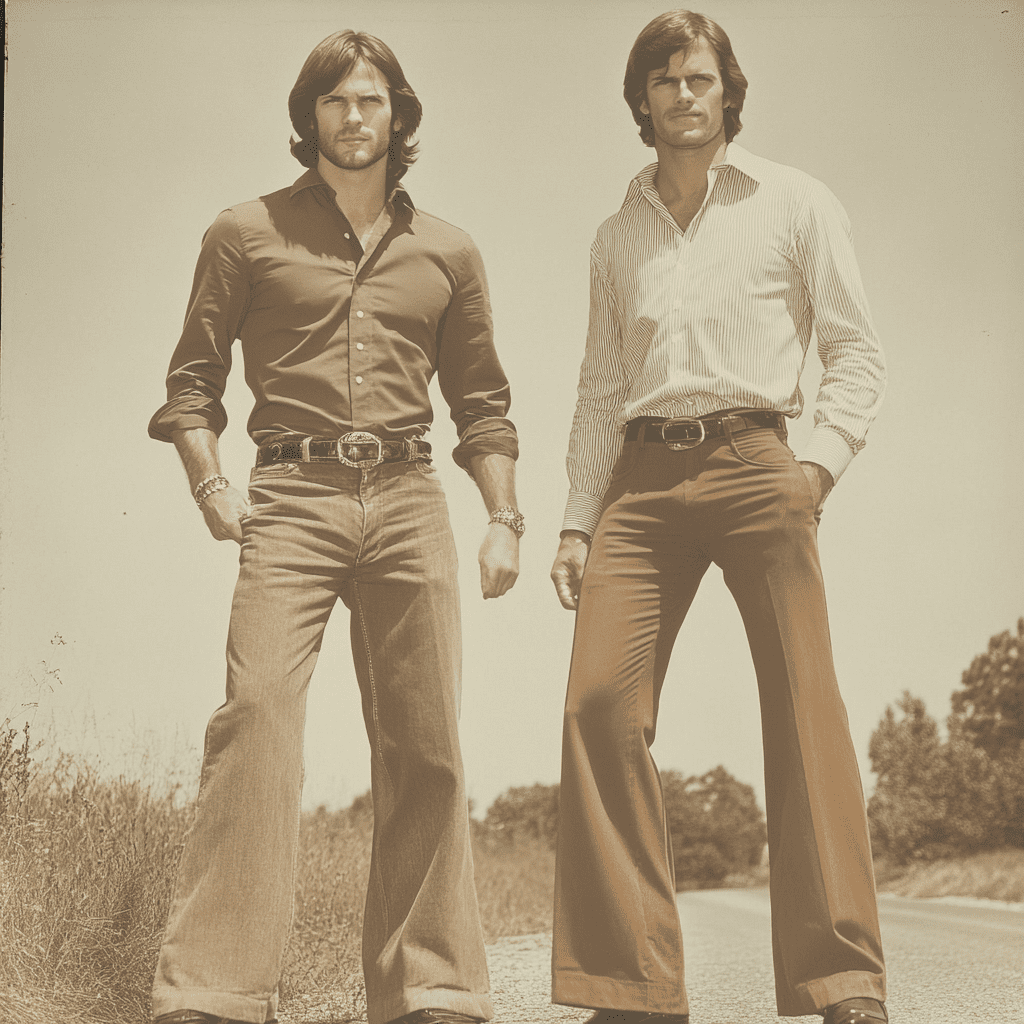
Perhaps no other piece of clothing represents 1970s fashion outfits for men as clearly as the bell-bottom pants. These flared trousers were a defining trend, worn by rock stars and everyday men alike. Bell-bottoms were often made of denim but could also be found in other materials like corduroy and polyester.
The flared design at the bottom of the trousers made them a statement piece, particularly when paired with platform shoes or boots. Many men wore bell-bottoms with bold, patterned shirts tucked in, showcasing both the trousers and the high-waisted design that was also popular at the time.
- Style Tip: For a classic 70s look, pair bell-bottoms with a tight-fitting, long-sleeved shirt and chunky platform shoes. Finish the look with a leather jacket for added edge.
- Modern Take: Today, bell-bottom-inspired trousers have been reimagined with a slightly slimmer flare. Pair them with loafers or low-top sneakers for a modern retro vibe.
3. The Leather Jacket: Rock ‘n’ Roll Cool
The 1970s were also marked by a rebellious, rock ‘n’ roll attitude, and leather jackets became a key part of the men’s fashion landscape. The most iconic leather jacket of the time was the classic biker jacket, worn by music icons like David Bowie and Iggy Pop. These jackets often featured asymmetrical zippers, bold metal hardware, and a cropped fit, perfect for adding an edgy touch to any outfit.
Leather jackets were often paired with tight jeans, graphic t-shirts, or band shirts to complete the rocker look. Whether on stage or on the street, the leather jacket was synonymous with rebellious energy and effortless style.
- Style Tip: Pair a vintage leather jacket with a pair of straight-leg jeans, a tucked-in t-shirt, and black boots for a timeless look.
- Modern Take: Today, the biker jacket is still a fashion staple. Try layering it over a slim-fit turtleneck or hoodie for a fresh, updated twist on the classic look.
4. The Bohemian Look: 70s Hippie Fashion
While the 60s initiated the hippie movement, the 1970s solidified bohemian fashion as a lasting cultural influence. The bohemian look was all about loose-fitting garments, natural fabrics, and earth tones. Think flowy tunics, peasant shirts, fringed vests, and flared pants.
One of the signature items of the bohemian look was the embroidered shirt or tunic, often featuring intricate designs, and worn untucked for a laid-back vibe. Men would also accessorize with beads, headbands, and aviator sunglasses to complete the carefree aesthetic. The hippie 70s men’s fashion emphasized individuality and was often embraced by free spirits, artists, and musicians.
- Style Tip: Wear a flowy tunic with flared jeans and sandals, and add accessories like leather bracelets or a woven headband to get the perfect bohemian vibe.
- Modern Take: To bring this look into the present, you can mix bohemian-inspired pieces with more tailored garments. For instance, try pairing a fringed vest with slim-fit jeans and Chelsea boots for a more polished yet relaxed look.
5. Retro Men’s Streetwear: Casual 1970s Fashion
For everyday wear, casual 70s men’s fashion was defined by comfortable, practical pieces that still made a statement. Men wore denim jackets, t-shirts with bold graphics, and sweaters with bright geometric patterns. The 70s also introduced the tracksuit, a popular choice for streetwear that combined both comfort and style. Popularized by athletes and later adopted by the masses, tracksuits became a staple of casual fashion.
Denim was the go-to fabric for casual looks, and Levi’s jeans dominated the market. Men’s denim jackets were worn with everything from t-shirts to knit sweaters, often layered over a collared shirt for a more dressed-up casual look.
- Style Tip: For a true retro streetwear vibe, pair a vintage Levi’s denim jacket with high-waisted jeans and a bold t-shirt featuring a vintage graphic design.
- Modern Take: Bring this look into today’s fashion by mixing different textures, like pairing denim with leather accessories or incorporating a modern graphic tee for a playful twist on the retro vibe.
6. The Sweater Vest: Academic Chic
The sweater vest might seem like a conservative choice today, but in the 1970s, it was a key piece for creating a preppy yet laid-back look. Worn over collared shirts or turtlenecks, the sweater vest added layers and depth to a casual outfit. It was particularly popular in cooler months, often paired with trousers or corduroy pants.
This look was embraced by both scholars and artists, offering a versatile option that could be dressed up or down.
- Style Tip: For a vintage preppy look, layer a patterned sweater vest over a collared shirt, and pair it with flared trousers and loafers.
- Modern Take: Today, the sweater vest can be styled with more contemporary pieces, like slim-fit trousers and sneakers, for a fresh, updated look.
7. Platform Shoes and Boots: Elevate Your Style
One of the most iconic accessories of 1970s men’s fashion was the platform shoe. Whether it was disco nights or casual streetwear, platform shoes and boots became an essential part of the 70s style. Made famous by bands like The Jackson 5 and KISS, platform shoes came in bold colors and daring designs, elevating both height and style.
- Style Tip: Pair platform shoes with bell-bottom jeans and a statement shirt for a head-turning, era-appropriate look.
- Modern Take: While platforms might seem extreme today, many brands offer subtle platform sneakers that bring a modern twist to the retro look.
Retro Men’s Streetwear and Casual 1970s Fashion: A Modern Interpretation
Today, 1970s retro fashion outfits for men continue to influence contemporary style, from high-end runways to streetwear brands. Vintage pieces like flared jeans, bold printed shirts, and aviator sunglasses are still staples in modern men’s wardrobes, reinterpreted for today’s fashion landscape. Many retailers offer 1970s mens fashion for sale, including authentic vintage pieces and modern remakes, allowing anyone to embrace this stylish era.
The 70s were all about pushing boundaries and embracing individuality, and those same values resonate with today’s fashion. From rock stars to everyday men, the 1970s fashion outfits for men left a lasting legacy that continues to inspire fashion trends across generations.
Retro Men’s Streetwear: Casual 1970s Fashion
The 1970s saw a shift in men’s streetwear, with casual fashion embracing boldness, creativity, and comfort. The decade was marked by a fusion of different influences, from the rock and roll scene to the counterculture movements, and these influences were reflected in the everyday outfits of men. 1970s streetwear casual fashion combined elements of denim, vibrant shirts, and distinctive accessories to create a look that was both effortless and stylish.
1. Denim as the Foundation
Denim was the go-to fabric for men in the 1970s. Whether it was jeans, jackets, or shirts, denim dominated casual fashion. Brands like Levi’s became synonymous with the era, producing high-waisted jeans with flared or straight legs that were perfect for casual streetwear. Men often paired denim jackets with graphic t-shirts or plaid shirts to create a laid-back yet fashionable look.
- Styling Tip: Wear a denim jacket with high-waisted jeans and a band t-shirt for an authentic 70s streetwear vibe. The look can be elevated by accessorizing with aviator sunglasses or a belt with a large buckle.
2. The Graphic T-Shirt Revolution
The 70s were when fashion 1970s mens shirts really made a mark with bold graphic designs. Men sported t-shirts emblazoned with band logos, psychedelic prints, or political statements. These shirts allowed men to express their personality and interests, making the graphic tee a staple of casual streetwear.
- Styling Tip: Pair a vintage-inspired graphic tee with flared jeans or chinos. Tuck in the shirt for a more refined 70s look, and add sneakers or loafers for a complete casual ensemble.
3. Bright and Bold Patterns
Shirts in the 1970s were all about vibrant patterns and colors. From paisley prints to geometric designs, men embraced boldness in their everyday attire. These shirts were often made from polyester, which was the fabric of choice for its shiny, sleek finish. Short-sleeved or long-sleeved, patterned shirts were paired with high-waisted trousers or jeans for a chic, casual look.
- Styling Tip: Opt for a brightly colored patterned shirt with earth-toned pants or jeans. You can also layer it with a casual jacket or a sweater vest to add dimension to the outfit.
4. Sweater Vests and Knitwear
Knitwear was another prominent feature of casual 1970s men’s fashion. Sweater vests, cardigans, and pullover sweaters in bold patterns or earthy tones were widely worn. Sweaters added warmth and style to everyday outfits and were often layered over collared shirts or worn alone.
- Styling Tip: A patterned sweater vest layered over a collared shirt with flared trousers and loafers can give a relaxed yet polished look. For a more laid-back approach, wear a chunky-knit sweater with denim.
5. Footwear Choices: Sneakers and Boots
Footwear played a significant role in casual streetwear. 1970s men’s casual fashion saw a rise in the popularity of sneakers and boots. Brands like Converse and Adidas became household names, with their sneakers being worn both for athletic activities and everyday style. Boots, particularly leather and suede, were also widely worn, especially with flared pants.
- Styling Tip: Wear classic white sneakers with high-waisted denim for a relaxed look. For a more rugged appearance, opt for brown suede boots or platform shoes.
6. Accessories for Casual Looks
Accessories were an integral part of completing the casual 1970s men’s fashion look. Men embraced wide-brimmed hats, aviator sunglasses, and leather belts with oversized buckles. These accessories added personality to their outfits and contributed to the era’s relaxed yet statement-making style.
- Styling Tip: Add a wide-brimmed hat or a retro belt to your outfit for a dash of 70s charm. Aviator sunglasses can also elevate any casual look.
The Evolution of Men’s Formal Fashion in the 1970s
While casual wear was all about bold prints and relaxed silhouettes, formal 1970s fashion men was an entirely different story. Men’s suits and formal wear underwent significant changes in the 70s, moving away from the conservative, restrained designs of previous decades to embrace boldness, color, and flair. The 1970s were a time when men’s formal fashion stepped into the spotlight, combining classic tailoring with the free-spirited energy of the era.
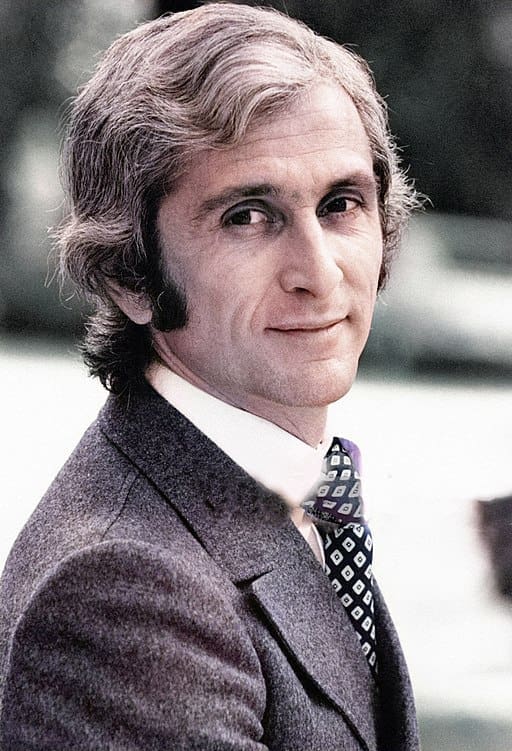
1. The Wide-Lapel Suit
One of the most iconic features of 1970s fashion men suits was the wide lapel. Suits were tailored with exaggerated lapels, often made from polyester, and came in a wide range of colors. Double-breasted suits with wide lapels were especially popular, worn by everyone from businessmen to movie stars. Men’s formal fashion embraced vibrant hues like mustard yellow, burgundy, and even pastel tones, making it one of the most colorful eras for suits.
- Styling Tip: For a true retro look, opt for a wide-lapel suit in a bold color like navy or brown, and pair it with a brightly patterned shirt. To bring it into the modern day, go for a slimmed-down version with a more tailored fit.
2. Flared Trousers
Much like casual fashion, flared trousers were a defining feature of formalwear. 1970s fashion men suits often included matching flared trousers that elongated the silhouette and added a touch of drama. These trousers were typically high-waisted, offering a sleek fit around the hips and thighs before flaring out at the hem.
- Styling Tip: Pair flared trousers with a fitted blazer for a clean, sharp look. Add heeled loafers or boots to complete the formal ensemble.
3. Velvet and Corduroy Suits
In terms of materials, the 1970s saw men’s suits made from luxurious fabrics like velvet and corduroy. These fabrics were popular for both formal and semi-formal occasions, adding texture and depth to men’s wardrobes. Velvet suits in deep jewel tones, such as emerald green and royal blue, were often worn to evening events, adding a touch of glamor and sophistication.
- Styling Tip: Choose a velvet blazer in a deep color and pair it with slim-fit trousers and loafers for a modern take on the retro formal look. For a more casual evening look, a velvet blazer can also be worn with dark jeans and a button-up shirt.
4. Ruffled Shirts and Bold Ties
Formal fashion wasn’t just about the suit itself; it was also about the accessories. Ruffled shirts, particularly in silk or satin, became a must-have for men’s formalwear, adding an element of drama to their outfits. Wide ties with bold patterns, including stripes and paisley prints, were essential for completing the look. These accessories emphasized the daring, bold spirit of 1970s men’s fashion.
- Styling Tip: For a fully authentic 70s formal look, pair a ruffled shirt with a wide tie and a velvet or polyester suit. In more modern contexts, a simple patterned tie paired with a plain shirt can bring in just a touch of retro flair.
5. Platform Shoes in Formal Fashion
While platform shoes are often associated with disco and casual wear, they also made their way into formal fashion in the 70s. Many men chose platform shoes or boots with formal suits to add height and make a bold statement.
- Styling Tip: For a more subtle approach, opt for heeled loafers or Chelsea boots instead of full platform shoes. These can still elevate the look without being overly dramatic.
In conclusion, both casual and formal men’s fashion in the 1970s were a celebration of boldness, experimentation, and individuality. Whether you’re looking to embrace the casual streetwear vibe or rock a wide-lapel suit, the 1970s offer endless inspiration for men’s fashion that remains timeless yet daring.
Exploring 1970s Men’s Fashion in the UK: A British Twist
The 1970s were a decade of transformation, experimentation, and rebellion in men’s fashion, especially in the UK. British fashion took on a distinct flavor during this period, shaped by cultural movements, music scenes, and the influence of iconic figures from the worlds of rock, film, and politics. London, in particular, became a hub of fashion innovation, with styles evolving from the remnants of 1960s Mod culture and exploding into the rebellious spirit of punk, glam rock, and disco.
Let’s explore the key trends in 1970s men’s fashion in the UK, looking at how British icons, movies, and subcultures defined the era and continue to influence fashion today.
The Mod Influence: Carryover from the 60s
At the beginning of the 1970s, 1970s mens fashion UK was still heavily influenced by the Mod movement that had defined the 1960s. Tailored suits, sharp lines, and polished looks were a staple for many British men in the early part of the decade. Men wore slim-fitting suits, often in muted colors like navy and grey, and paired them with pointed leather shoes and neat haircuts.
- Famous Icons: Paul Weller, frontman of The Jam, was a key figure representing the Mod revival that spilled into the 1970s. His look influenced young men throughout the UK, with his sharp suits and love for tailored styles setting the tone for the Mod aesthetic.
- Films: Movies like Quadrophenia (1979) captured this cultural moment, showcasing the Mod look and attitude. The film, set in the 1960s but released at the end of the 70s, became a significant cultural touchstone, offering a nostalgic yet modern take on Mod style.
Glam Rock and Androgyny: Pushing Boundaries
As the 1970s progressed, British fashion saw the rise of glam rock, a genre that combined theatricality, flamboyance, and androgyny. Glam rockers wore bold, glittering outfits, tight-fitting jumpsuits, platform boots, and dramatic makeup. London, with its eclectic fashion scene, became a hotbed for this look, which rebelled against traditional masculinity and embraced self-expression.
- Famous Icons: David Bowie, Marc Bolan of T. Rex, and Freddie Mercury were among the leading figures of the glam rock movement. Bowie’s alter ego, Ziggy Stardust, embodied the essence of glam fashion—bright, futuristic, and gender-fluid. His outlandish costumes, sparkling makeup, and fearless embrace of androgyny became the defining look of glam rock.
- Films and TV: Bowie’s appearance in The Man Who Fell to Earth (1976) added to his status as a style icon, and the film’s futuristic visuals matched the glam aesthetic of the era. Shows like Top of the Pops also contributed to the spread of glam fashion, with artists frequently appearing in eye-catching, eccentric outfits.
Punk: The Rebellion Against the Establishment
By the mid-70s, punk rock was emerging as a reaction against the perceived excess of glam rock and the mainstream. Punk fashion, heavily associated with London, was deliberately anti-establishment, with its DIY ethos and aggressive edge. Safety pins, ripped clothes, leather jackets, and combat boots were the uniform of punk rockers, and these styles contrasted sharply with the tailored Mod looks of the earlier decade.
- Famous Icons: The Sex Pistols, fronted by Johnny Rotten, and The Clash, with Joe Strummer as their iconic figure, were central to the punk movement. Vivienne Westwood, a designer based in London, was one of the pioneers of punk fashion, designing the band’s clothing and establishing the look of the punk scene.
- Films and Pop Culture: Sid and Nancy (1986), though released after the 1970s, told the story of Sid Vicious of the Sex Pistols and helped cement the visual iconography of punk culture. Meanwhile, shows like The Old Grey Whistle Test featured performances by punk bands, influencing the spread of the movement.
The Disco Influence: Taking Cues from Across the Atlantic
Though disco originated in the United States, it quickly made its way across the Atlantic to the UK, influencing 1970s London mens fashion and bringing with it a more relaxed, yet still glamorous, style. Disco fashion for men included fitted shirts with wide collars, flared trousers, and shiny fabrics like polyester and satin. While punk and glam rock catered to a rebellious crowd, disco fashion was all about fun and celebration.
- Famous Icons: John Travolta’s role in Saturday Night Fever (1977) brought disco fashion to a global audience, and British men eagerly adopted similar styles, donning wide-collared shirts, flashy suits, and platform shoes for nights out at the discotheque.
- Music and Clubs: Clubs like The Roxy in London were famous for playing disco music, and fashion was a significant part of the disco scene, with men sporting their best shiny suits and wide-lapelled jackets for nights on the dance floor.
1970s Formalwear: The British Take on Suits
Men fashion 1970s UK formalwear had its own distinctive flair. British men took inspiration from international trends while adding their twist, particularly in suits. Wide-lapelled jackets and flared trousers were staples of 70s formal attire, and much of the look focused on striking a balance between formality and personal expression. Materials such as velvet and corduroy added texture to these formal outfits, while colors became bolder than the traditional blacks and greys of previous decades.
- Famous Icons: Mick Jagger, known for his bold personal style, often wore brightly colored suits and patterned shirts, mixing rock-and-roll swagger with formal elegance. Similarly, Elton John’s theatrical outfits blurred the lines between formalwear and performance art.
Conclusion
The 1970s mens fashion UK scene was diverse, colorful, and rebellious, reflecting the social changes of the era. From the polished looks of early Mod influences to the flamboyant outfits of glam rockers and the gritty edge of punk, British men in the 1970s found countless ways to express themselves through fashion.
Today, the styles of 1970s London men’s fashion continue to inspire modern designers and retro enthusiasts alike, with vintage stores across the UK offering 1970s mens fashion for sale to those looking to capture the bold, expressive looks of the decade. Whether through Mod tailoring, glam rock theatrics, or punk’s anarchic attitude, British fashion from the 1970s remains a powerful influence on men’s style worldwide.
Men’s Winter Fashion in the 1970s: Cold Weather Styles
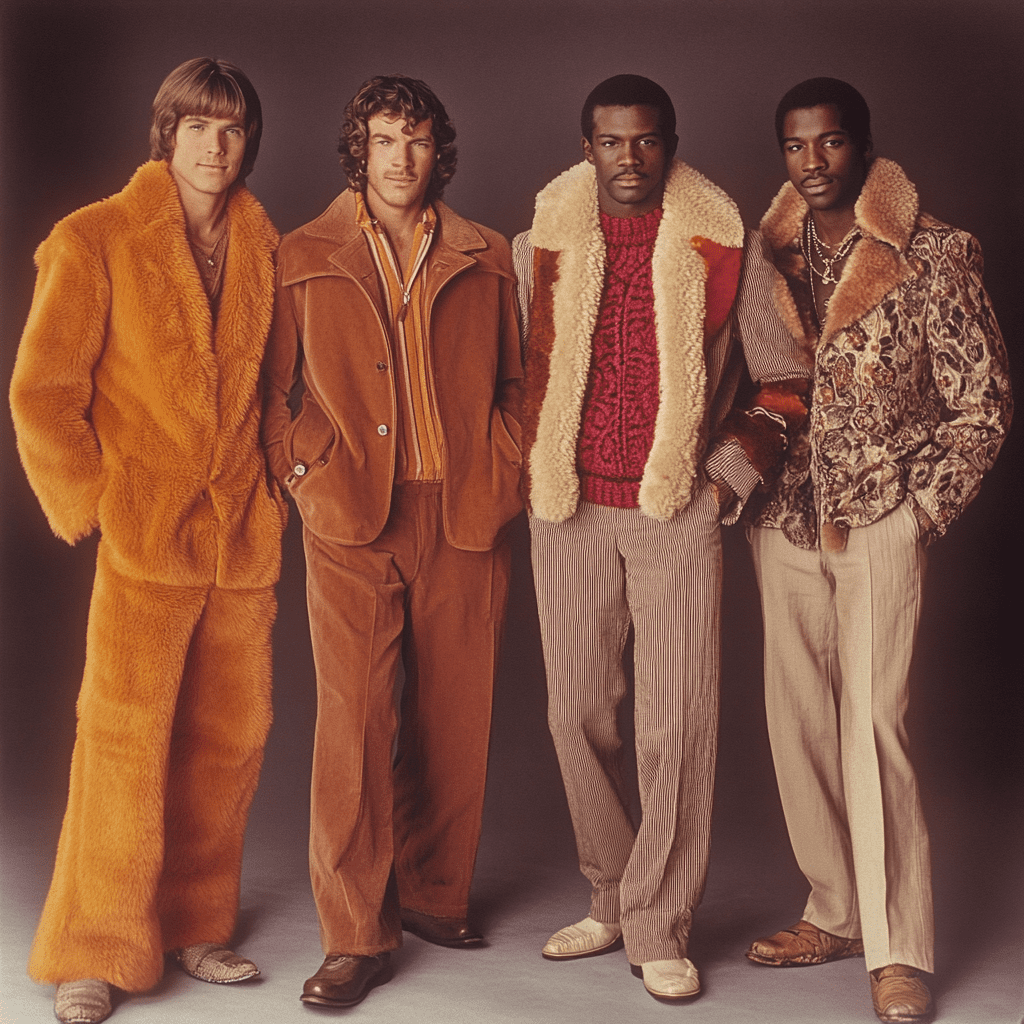
The 1970s were a decade of bold experimentation, not just in music, culture, and design, but also in fashion. While the era is often associated with the iconic flares, bright colors, and disco influences, 1970s winter fashion for men also had a distinctive edge, combining practicality with style. Men’s winter wear in the 1970s incorporated layers, textures, and diverse influences ranging from Mod to hippie aesthetics, with a focus on keeping warm while still making a fashion statement.
Let’s explore the key elements of 1970s men’s winter fashion, highlighting the cold-weather essentials that made this era’s style unforgettable.
1. The Iconic Shearling Coat
One of the most popular pieces in 1970s winter men’s fashion was the shearling coat. This thick, wool-lined coat became an iconic cold-weather essential for men, offering both warmth and a touch of rugged sophistication. Whether in full-length coats or shorter bomber-style jackets, shearling dominated the decade’s winter outerwear scene.
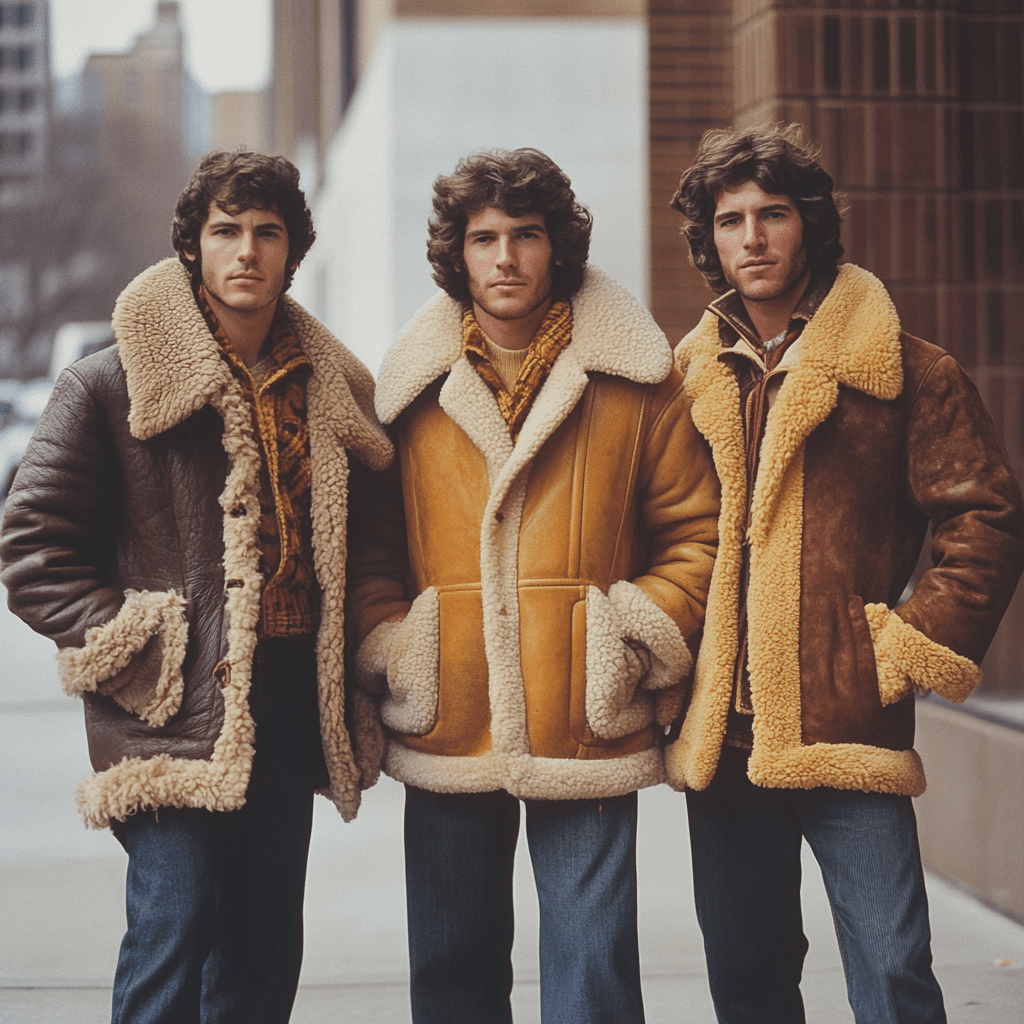
Style and Materials: These coats were often made from suede or leather with an inner lining of soft shearling (lamb or sheepskin), providing the necessary insulation for the colder months. The contrast between the soft interior and the tough exterior material added a stylish, textured look to any winter outfit.
- Famous Icons: Actors like Robert Redford and Steve McQueen sported shearling coats, embodying a laid-back, masculine style that resonated with audiences. Redford’s appearance in The Great Gatsby (1974) particularly helped to popularize this winter staple.
- How to Style It: Shearling coats were often paired with jeans, turtleneck sweaters, or corduroy trousers, allowing for a mix of casual and formal elements.
2. Wool and Turtleneck Sweaters
When it came to winter layering, 1970s winter men’s fashion saw an abundance of turtleneck sweaters and wool pullovers. These garments were not only practical but also played a significant role in creating a streamlined, sophisticated look. Turtlenecks were particularly versatile and worn in both casual and formal settings during the cold months.
- Style and Fabrics: Wool, cashmere, and synthetic fibers were used to create these winter essentials, which often came in rich, earthy tones like brown, olive, and mustard. Striped and patterned knit sweaters, especially with geometric or Nordic designs, were also popular.
- Famous Icons: Paul Newman and Michael Caine were frequently seen sporting turtlenecks, both on-screen and off. Newman’s minimalist style, paired with turtleneck sweaters under jackets, became a classic look that emphasized sleek, understated fashion.
- How to Style It: Turtlenecks were layered beneath blazers or shearling coats for a more polished look, while chunky knit sweaters were paired with jeans or corduroy trousers for casual winter outings.
3. The Peacoat: Military-Inspired Outerwear
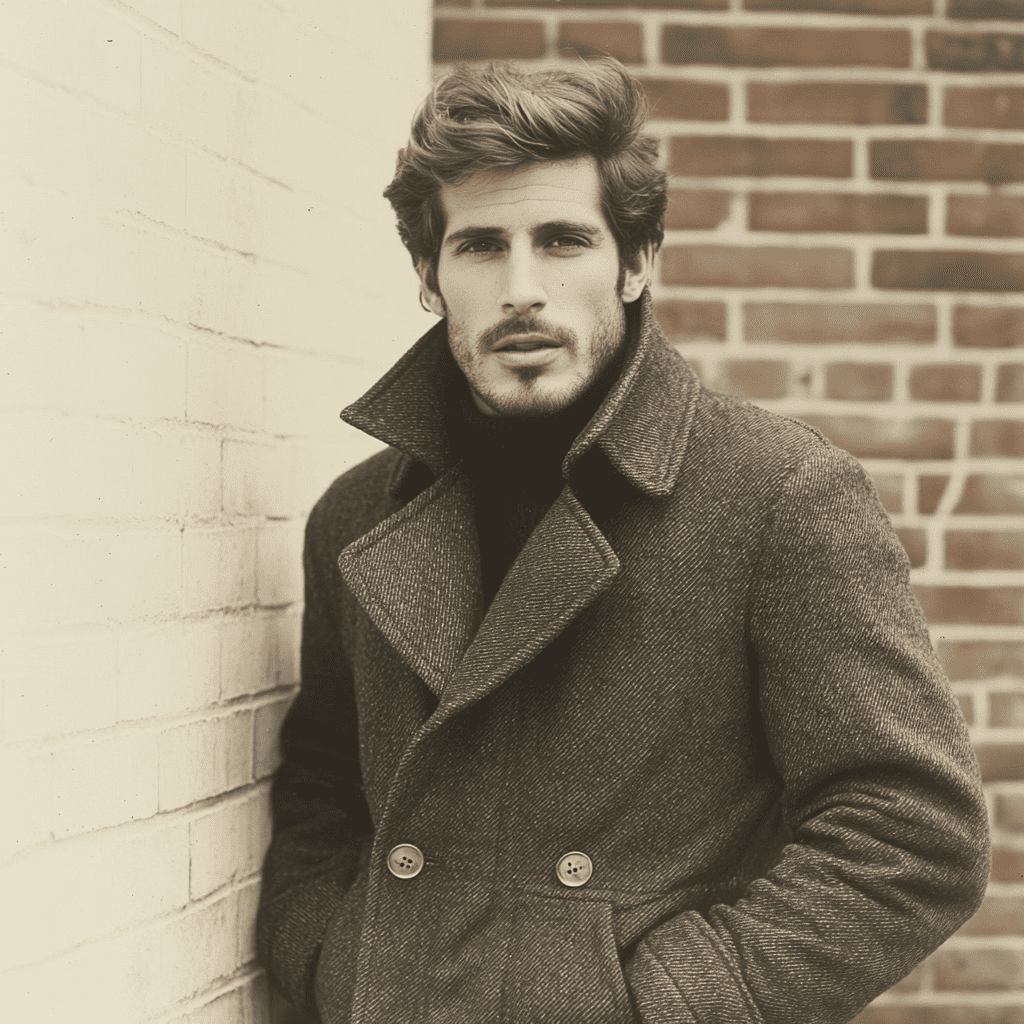
The peacoat was another essential piece in 1970s winter fashion for men. Originating from naval uniforms, this double-breasted, short-length coat became a wardrobe staple for men looking for practical yet stylish winter outerwear. Peacoats were typically made from heavy wool to provide warmth and were designed with a tailored fit, making them both functional and sharp.
Style and Colors: Peacoats were most commonly found in navy blue, black, and grey, colors that added to their versatile and timeless appeal. The classic oversized lapels and brass buttons were standout features that gave the coat a distinctive military-inspired look.
- Famous Icons: British actor Michael Caine was often seen wearing peacoats during the 1970s, embodying a clean, modern take on this traditional piece. The peacoat’s association with Mod fashion also made it popular among younger men in the UK.
- How to Style It: Men paired peacoats with slim trousers, leather gloves, and flat caps for an urban, cold-weather look. This coat transitioned easily from day to evening wear, making it ideal for both work and social events during the winter.
4. Flared Trousers and Corduroy: Staying Warm with Style
Trousers in the 1970s winter men’s fashion were not just functional—they were also bold and stylish. Flared trousers, an iconic feature of the decade, were popular year-round, and winter versions came in heavier fabrics like wool and corduroy. Corduroy pants were especially favored during the colder months, providing extra warmth and texture while maintaining a sophisticated, yet relaxed look.
- Style and Fabrics: Flared trousers, including corduroy versions, often came in neutral tones such as brown, beige, and deep green, allowing men to match them with sweaters, coats, or blazers. High-waisted designs were common, elongating the silhouette, especially when paired with platform boots or heeled shoes.
- Famous Icons: David Bowie, while known for his glam rock style, often incorporated tailored flared trousers into his winter looks, blending androgynous fashion with functional cold-weather outfits.
- How to Style It: Corduroy trousers could be paired with chunky knit sweaters and turtlenecks, while flared wool trousers worked well with boots and a peacoat or shearling jacket for a casual yet polished winter look.
5. Accessories: Scarves, Hats, and Gloves
Winter fashion wouldn’t be complete without the accessories, and the 1970s didn’t disappoint. Scarves, knit hats, and leather gloves became key elements of 1970s winter men’s fashion, allowing men to stay warm while making a bold fashion statement.
- Style and Fabrics: Wool and cashmere scarves, often in bold patterns or plaid designs, were draped over coats or sweaters to add a pop of color to winter outfits. Knit hats in earthy tones like brown and rust were also popular, and leather gloves in black or brown helped complete the cold-weather look.
- Famous Icons: Actor Alain Delon, known for his sharp European style, often wore scarves and gloves in his winter outfits, blending practicality with a timeless, elegant appeal.
- How to Style It: Accessories were meant to complement the overall look. A wool scarf could be paired with a peacoat or leather jacket, while knit hats added a casual touch to more formal outfits. Gloves, particularly leather ones, gave an edge to both casual and formal wear.
6. Footwear: The Return of Boots
1970s winter men’s fashion also saw the rise of boots as a major trend. During the colder months, leather boots and platform shoes (for the bolder men) were paired with everything from flared trousers to jeans. Winter boots often had a rugged yet stylish look, designed to keep feet warm while adding height and flair to any outfit.
- Style and Fabrics: Leather boots in dark shades like black, brown, and tan were staples. For a more adventurous look, men opted for platform boots with chunky heels, especially for nighttime events. Fur-lined boots also gained popularity for their practicality in harsher climates.
- Famous Icons: Mick Jagger and Elton John were often seen wearing platform boots during the 1970s, influencing the widespread acceptance of these daring footwear choices for winter.
- How to Style It: Leather boots were worn with straight-leg or flared trousers, often paired with a thick-knit sweater or tailored jacket for a smart, stylish winter look. Platform shoes, on the other hand, were reserved for more avant-garde outfits, adding a sense of fun and glamour to cold-weather fashion.
Conclusion
1970s winter men’s fashion was all about balancing warmth with flair. From the iconic shearling coat to corduroy trousers and turtlenecks, winter fashion in the 70s offered a blend of practicality, style, and self-expression. Accessories like scarves and boots were not just functional—they also added a finishing touch to winter outfits.
British icons like David Bowie, Michael Caine, and Robert Redford were at the forefront of these fashion trends, making the 1970s a decade where men could experiment with bold designs while staying cozy. The era’s winter fashion continues to inspire contemporary styles, proving that the 1970s were not only about daring looks but also timeless trends that remain relevant today.
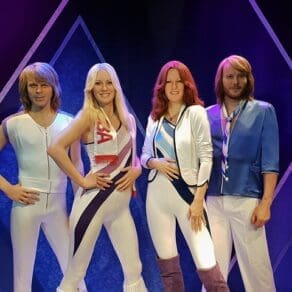
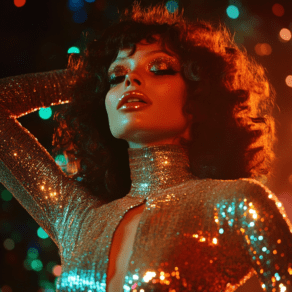
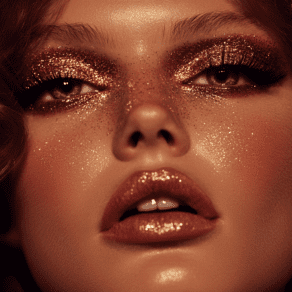
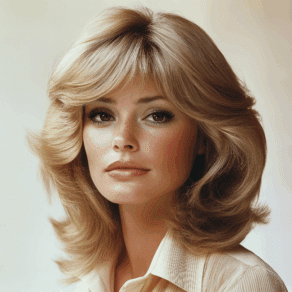
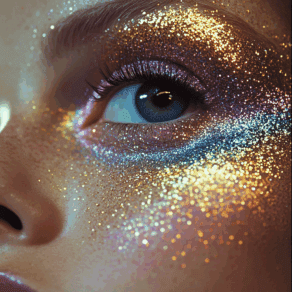
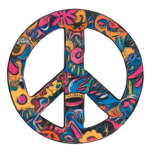
Leave a Comment